5.1: Slavery and Civil Rights
5.1.1: Slavery and the Abolitionist Movement
Slavery continued until 1865, when abolitionists argued against its conditions as violating Christian principals and rights to equality.
Learning Objective
Describe the history of slavery in the United States and early efforts at abolition
Key Points
- By 1860, four million people lived in slavery in the US. Most were people who had been brought from Africa and their descendants.
- Most people living as slaves worked in agriculture, including in the cotton industry, which was a key industry in the southern states. Enslaved people had few rights and were often subjected to harsh and violent living conditions.
- Abolitionists argued against slavery because of its harsh conditions, and through claims that slavery violated Christian principals and the natural rights of all people for equality.
- Most Northern states moved to end slavery by 1804.
- Freed slaves often continued to face racial segregation and discrimination.
- The conflict over slavery became a key catalyst for the Civil War.
Key Terms
- manumission
-
release from slavery, freedom, the act of manumitting
- Underground Railway
-
a network of secret routes and safe houses used by 19th-century black slaves in the United States to escape to free states and Canada with the aid of abolitionists and allies who were sympathetic to their cause
- chattel slavery
-
people are treated as the personal property, chattels, of an owner and are bought and sold as commodities
Slavery in the US
While the US was founded on principles of representation, due process and universal rights, slavery remained one of the most persistent and visible exceptions to these ideals.
Slavery, including chattel slavery, was a legal institution in the US from the colonial period until the Emancipation Proclamation (1863) and Thirteenth Amendment of the Constitution (1865). Most slaves in the US were people brought from Africa and their descendants, and this racial dimension of US slavery continues to impact US civil rights debates. By 1860, four million people lived as slaves in the US, and most worked in the agriculture sector. The rise in the southern cotton industry after 1800 also led to a steady increase in slavery, which then became a major catalyst for the Civil War.
Conditions of Slavery
The conditions of slavery were harsh, starting with the “middle passage” where Africans were stuffed into the hulls of ships like cargo. Some fifteen percent of enslaved people are estimated to have died during travel from Africa. In the US the conditions of slavery acted to dehumanize enslaved people denying them even basic rights. The use of native languages was banned, and it was illegal to learn or teach reading and writing. Marriages were banned, and children were often taken away from parents to be sold. It was also common for slave owners to sexually assault enslaved women. Finally, working conditions were long and hard, especially for field workers, and violence was an ever present part of life.
Abolition
Throughout this period many people worked to end slavery. Early abolitionist legislation included Congress prohibiting slavery in the Northwest Territory (1787), and a ban on the import or export of slaves (1808) in the US and Britain. Resistance to slavery also took other forms including institutions such as the Underground Railway that helped escaping slaves make their way to freedom.
Abolitionists came from various communities including religious groups such as the Quakers, white anti-slavery activists such as Harriet Beecher Stowe, and former slaves and free people of color such as Frederick Douglass, Robert Purvis and James Forten. While some abolitionists called for an immediate end to slavery, others favored more gradual approaches. These included the banning of slavery in the territories, and manumission campaigns encouraging individual owners to free slaves.
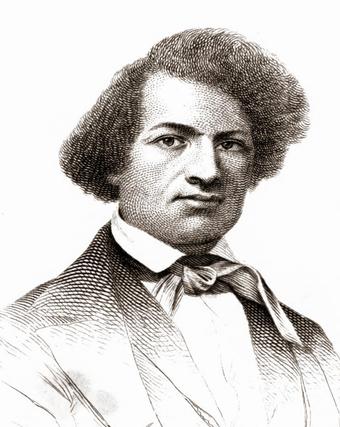
Frederick Douglass
Frederick Douglass was a freed slave prominent abolitionist and rights advocate.
Arguments against Slavery
Abolitionists used several arguments against slavery. As early as 1688, Quakers in Germantown, Pennsylvania presented a petition to end slavery based on religious obligation and natural rights to equality. In 1774, a group of enslaved people in Massachusetts petitioned the governor against slavery used similar arguments including the natural rights of all people, the demands of Christian brotherhood, and the harsh conditions of slavery. By the 1830s, evangelical groups became quite active in the abolitionist movement including the formation of the American Anti-Slavery Society in 1833. These groups often also supported other reform movements such as temperance movements and supports for public schools.
Early politicians and constitutional authors including Thomas Paine, Alexander Hamilton and Thomas Jefferson also had reservations about slavery because of their commitment to equal rights. However, many of these same politicians also owned slaves.
Gradual Abolition and Conflict
By 1804, most of the northern states had moved towards the abolition of slavery. although this process was quite gradual, and freed slaves were often subject to racial segregation and discrimination. Manumission campaigns in the Upper South were also successful in increasing the number of free people of color in Virginia, Maryland and Delaware where, by 1810, three-quarters of Black people in Delaware were free.
Support for slavery remained the strongest in the southern states where slavery was an important economic institution for cotton and other agricultural industries strongest in the South. The conflict over slavery became a key catalyst for the Civil War that divided northern and southern states.
5.1.2: Abolitionism and the Women’s Rights Movement
Many women involved in the early abolitionist movement went on to be important leaders in the early women’s rights and suffrage movements.
Learning Objective
Describe the relationship between the women’s rights and anti-slavery movements
Key Points
- There were many progressive movements active in the pre-civil war era. The abolition and women’s rights movement were two of the most important.
- The two movements tied together as many women involved in early abolition became leaders in the women’s rights and suffrage movements.
- The women’s rights movement applied the arguments for human rights and equality used in the abolition movement to their own lives and demanded equal consideration for women.
- There were divisions within the abolition movement over the role of women, and whether they should be subordinate, or if it was appropriate for women to take more public or leadership roles in the movement.
- While the pre-civil war women’s rights movement had few major victories it set the ground work for the suffrage campaigns that would occur in the early 20th century, along with women’s rights, feminist and women of color movements that continue today.
Key Terms
- women’s rights movement
-
the political and social actions of individuals and organizations focused on the empowerment and equal treatment of women
- suffrage
-
The right or chance to vote, express an opinion, or participate in a decision.
Progressive Pre-War Period
A wide variety of progressive movements grew up during the decades leading up to the US Civil War. The activists involved hoped to make significant changes in society, including expanding rights and freedoms to a larger group of people living in the US.
Two of the most influential were the anti-slavery or abolitionist movement, and the women’s rights movement. These were also closely related as many of the women who would go on to be leaders in the women’s rights movement got their political start in the abolitionist movement.
While many women were active in the abolitionist movement they were often kept out of public, leadership and decision making positions. For example only two women attended the Agents’ Convention of the American Anti-Slavery Society in 1836. Women began to form their own abolition groups, organizing events such as the Anti-Slavery Convention of American Women held in 1837. This convention brought 200 women to New York City, where they called for the immediate abolition of slavery in the US. The delegates argued for an end to slavery based on the often brutal conditions of slavery, as well as the ways in which slavery violated christian principals and basic human right to equality.
Women’s Rights Movement
Women involved in the early abolitionists movement also began to connect demands for equal right to their own lives and experiences, advocating for expanded education, employment and political rights including suffrage.
The 1848 Seneca Falls convention is one of the key early moments in the suffrage and women’s rights movement in the US. The convention was organized primarily by a group of Quaker women during a visit by Lucretia Mott, a Quaker woman well known for her role in the abolition movement and advocacy for women’s rights. The convention brought together 300 people, men and women, and produced a strong Declaration of Sentiments advocating for women’s equality including the right to vote.
The Intersection of Race and Gender
As progressive movements grew, several divisions developed often over questions of identity and especially over the role women and people of color in the movements. In terms of Abolition more incremental groups preferred advocating against the expansion of slavery, but would often stop short of calling for full or immediate abolition. Supporters of this strategy often also advocated for colonization for freed slaves, a strategy that would see emancipated people sent to colonies established in Africa, such as Liberia.
Many advocates of incremental abolition and colonization also held more traditional views on the role of women, claiming that women should play a supporting role in both the abolitionist movement and in society more generally.
A more progressive and radical strain of abolition maintained that rights and moral standing were universal, and that whether people were of African or European decent, men or women they were all due to equal treatment and rights.
A well-known exchange between Catherine Beecher and Angelina Grimké two prominent women activists and writers highlighted these two perspectives. Beecher argued women should remain subordinate by divine law in her Essay on Slavery and Abolitionism with Reference to the Duty of American Females. While Grimké asserts the rights of women to engage in all political institutions that impact their lives.
The role of Black women in the suffrage movement was also sometimes problematic. For example, both emancipated women who had been slaves and free women of color were active in the abolitionist movement, but as the women’s movement grew there was often resistance on the part of the increasingly middle class, educated, white leadership to include Black women. For example while Sojourner Truth spoke to the Women’s Convention in Akron Ohio in 1851 there were conflicting reports over how the speech was received. Some claimed delegates welcomed both the speaker and message, and others claimed that delegates were hostile to having a Black speaker address them.
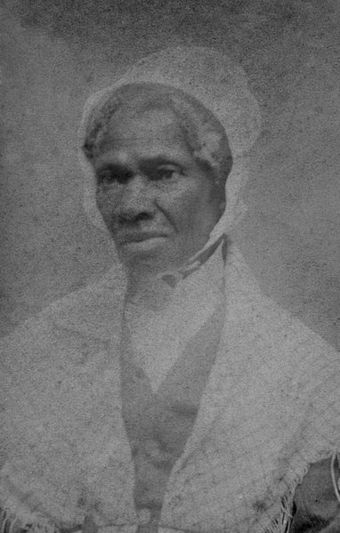
Sojourner Truth
Sojourner Truth who had been bom into slavery won her own freedom and became a prominent abolitionist and women’s rights advocate.
Outcomes and Legacy
While women did not gain the right to vote in all sates until 1920, there were still some victories won for women’s rights in the period leading up to the Civil War. One of the most notable was New York State granting property rights to married women. This period of activism also set the foundation for the suffrage campaigns that would occur in the early 20th century, along with women’s rights, feminist and women of color movements that continue today.
5.1.3: The Civil War Amendments
The Civil War Amendments protected equality for emancipated slaves by banning slavery, defining citizenship, and ensuring voting rights.
Learning Objective
Identify the key provisions of the three Civil War amendments
Key Points
- The 13th, 14th, and 15th Amendments, known collectively as the Civil War Amendments, were designed to ensure equality for recently emancipated slaves.
- The 13th Amendment banned slavery and all involuntary servitude, except in the case of punishment for a crime.
- The 14th Amendment defined a citizen as any person born in or naturalized in the United States, overturning the Dred Scott V. Sandford (1857) Supreme Court ruling stating that Black people were not eligible for citizenship.
- The 15th Amendment prohibited governments from denying U.S. citizens the right to vote based on race, color, or past servitude.
Key Terms
- Emancipation Proclamation
-
An executive order issued by Abraham Lincoln on January 1, 1863, during the American Civil War. It proclaimed the freedom of slaves in 10 states that were still in rebellion.
- Jim Crow
-
Southern United States racist and segregationist policies in the late 1800’s and early to mid 1900’s, taken collectively.
- Civil War Amendments
-
The 13th, 14th, and 15th Amendments to the United States Constitution.
The Civil War Amendments
The 13th (1865), 14th (1868), and 15th Amendments (1870) were the first amendments made to the U.S. constitution in 60 years. Known collectively as the Civil War Amendments, they were designed to ensure the equality for recently emancipated slaves.
While the Emancipation Proclamation ended slavery in the 10 states that were still in rebellion, many citizens were concerned that the rights granted by war-time legislation would be overturned. The Republican Party controlled congress and pushed for constitutional amendments that would be more permanent and binding. The three amendments prohibited slavery, granted citizenship rights to all people born or naturalized in the United States regardless of race, and prohibited governments from infringing on voting rights based on race or past servitude.
The 13th Amendment
This amendment explicitly banned slavery and involuntary servitude in the United States. An exception was made for punishment of a crime. This amendment also gave Congress the power to enforce the article through legislation.
The 14th Amendment
This amendment set out the definitions and rights of citizenship in the United States. The first clause asserted that anyone born or naturalized in the United States is a citizen of the United States and of the state in which they live. It also confirmed the right to due process, life, liberty, and property. This overturned the Dred Scott v. Sandford (1857) Supreme Court ruling that stated that black people were not eligible for citizenship.
The amendment also defined the formula for determining political representation by apportioning representatives among states based on a count of all residents as whole persons. This contrasted with the pre-Civil War compromise that counted enslaved people as three-fifth in representation enumeration. Southern slave owners wanted slaves counted as whole people to increase the representation of southern states in Congress. Even after the 14th Amendment, native people not paying taxes were not counted for representation.
Finally, the amendment dealt with the Union officers, politicians, and debt. It banned any person who had engaged in insurrection or rebellion against the United States from holding civil or military office. Finally, it declared that no debt undertaken by the Confederacy would be assumed by the United States.
The 15th Amendment
This amendment prohibited governments from denying U.S. citizens the right to vote based on race, color, or past servitude.
While the amendment provided legal protection for voting rights based on race, there were other means that could be used to block black citizens from voting. These included poll taxes and literacy tests. These methods were employed around the country to undermine the Civil War Amendments and set the stage for Jim Crow conditions and for the Civil Rights Movement.
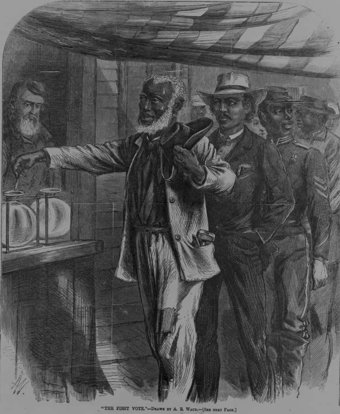
The First Vote
This image depicts the first black voters going the polls.
5.1.4: The NAACP
The NAACP, which was founded in 1909, advocates for full civil liberties and an end to racial discrimination and violence.
Learning Objective
Identify the key figures and groups working for racial equality in early twentieth-century America
Key Points
- Discrimination and violence against people of color and especially Black people continued into the 1900s, and led several groups to organize against discrimination.
- The NAACP was founded in 1909, and organized around full civil liberties and and end to racial discrimination and violence including lynching.
- The NAACP focused on local organizing with 300 branches by 1919.
- The NAACP’s worked continued to evolve and they organized campaigns around voting rights, education and employment.
Key Term
- lynching
-
Execution of a person by mob action without due process of law, especially hanging.
Organizing for Equality: The NAACP
At the beginning of the 1900s the conditions for people of color, and particularly Black people in the US were incredibly unequal. Most Black people in the US were descendants of people who had lived in slavery in the US, and particularly in the South they experienced legal segregation, limitations on civil rights and liberties, and high rates of violence including lynching. During this period several groups began organizing, particularly around defending rights won under the thirteenth, fourteenth and fifteenth amendments. The NAACP (National Association for the Advancement of Colored People) was one of these groups.
W.E.B. Du Bois and the Niagara Movement
W.E.B. Du Bois was a scholar and activist committed to full civil rights for all people. His worked extended beyond the US, and he was also a Pan-Africanist and supported anti-colonial actions in Africa and Asia.
In 1905 Du Bois along with William Monroe Trotter convened the first meeting of the Niagara Movement in Niagara Falls in Ontario. This group of Black activists and scholars called for full civil liberties and an end to racial discrimination. Their approach contrasted with other groups at the time calling for more gradual reform.
The NAACP
In 1909 the NAACP formed, the fist call for a meeting was send out by a group of white liberals appalled by the continued violence committed against Black people in the US . W.E.B. Du Bois was one of a small group of Black participants in the first meeting, and his focus on defending the rights granted in the thirteenth, fourteenth and fifteenth amendments and eliminate race prejudice were adopted by the group.
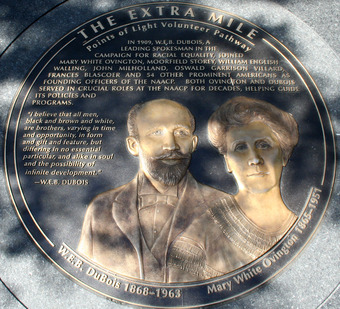
The NAACP
W.E.B. Du Bois and Mary White Ovington were two of the founding officers of the NAACP.
The NAACP focused on recruiting members and local organizing. Branch offices were established in cities such as Washington DC, Kansas City MO, Detroit MI, and Boston MA. by 1919 they had tens of thousands of members and hundreds of local chapters.
In the early years the NAACP campaigned vigorously against lynching, voter suppression laws, for education rights, and blocked the nomination of a segregationist Supreme Court Judge. During the great depression the NAACP moved to organizing around the disproportionate impact of the depression on Black workers, and worked with willing unions to help secure jobs.
5.1.5: Litigating for Equality After World War II
Post-WWI civil rights were expanded through court rulings such as Brown v. Board of Education (1954), which helped integrate public schools.
Learning Objective
Describe the decision in Brown v. Board of Education
Key Points
- The period after World War II saw a great expansion in Civil Rights. This was achieved through a diversity of tactics including ongoing litigation.
- The best know case from this period is Brown v. Board of Education (1954), a Supreme Court case in which justices unanimously decided to reverse the principle of separate but equal. The decision led to the legal integration of public schools.
- While Brown v. Board of Education paved the way for integration in schools and other spheres of life, not everyone supported this decision. Many white people in southern states protested against integration and legislators thought up creative ways to get around the ruling.
Key Terms
- “Separate but Equal”
-
A legal doctrine in United States constitutional law that justified systems of segregation. Under this doctrine, services, facilities and public accommodations were allowed to be separated by race, on the condition that the quality of each group’s public facilities was to remain equal.
- Brown v. Board of Education
Litigating for Equality after World War II
The period after World War II saw a great expansion in civil rights. This was achieved through a diversity of tactics including ongoing litigation.
The best know case from this period is Brown v. Board of Education (1954), a Supreme Court case in which justices unanimously decided to reverse the principle of separate but equal. The decision led to the legal integration of public schools.
Brown v. Board of Education was a collection of cases that had been filed on the issue of school segregation from Delaware, Kansas, South Carolina and Washington DC. Each case was brought forward through NAACP local chapters. In each case except for Delaware, local courts had upheld the legality of segregation. The states represented a diversity of situations ranging from required school segregation to optional school segregation.
Segregation as Unconstitutional
Rather than focusing on whether or not segregated schools were equal, the Supreme Court ruling focused on the question of whether a doctrine of separate could ever be said to be equal. The judges’ ruling hinged on an interpretation that took separate as unconstitutional particularly because “Segregation of white and colored children in public schools has a detrimental effect upon the colored children. The impact is greater when it has the sanction of the law, for the policy of separating the races is usually interpreted as denoting the inferiority of the negro group. A sense of inferiority affects the motivation of a child to learn. “
School Integration and Resistance
Brown v. Board of Education paved the way for integration in schools and other spheres of life, but not everyone supported this decision. Many white people in southern states protested integration, and legislators thought up creative ways to get around the ruling. This case was just one step on the road to providing full civil liberties for all people living in the United States.
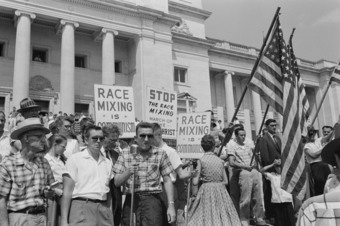
Anti-Integration Protest
A 1959 rally in Little Rock AK protests the integration of the high school.
5.2: The Civil Rights Movement
5.2.1: Separate But Equal
Separate but equal was a legal doctrine in American constitutional law that justified systems of segregation.
Learning Objective
Discuss the reasoning behind the separate of “Separate but Equal” before the Civil Rights Movement
Key Points
- Under this doctrine, services, facilities and public accommodations were allowed to be separated by race, on the condition that the quality of each group’s public facilities was to remain equal.
- Although the Constitutional doctrine required equality, the facilities and social services offered to African-Americans were almost always of lower quality than those offered to white Americans.
- The doctrine of “separate but equal” was legitimized in the 1896 Supreme Court case, Plessy v. Ferguson.
Key Term
- Reconstruction
-
A period in U.S. history from 1865 to 1877, during which the nation tried to resolve the status of the ex-Confederate states, the ex-Confederate leaders, and the Freedmen (ex-slaves) after the American Civil War.
Separate but equal was a legal doctrine in American constitutional law that justified systems of segregation. Under this doctrine, services, facilities and public accommodations were allowed to be separated by race on the condition that the quality of each group’s public facilities was to remain equal.
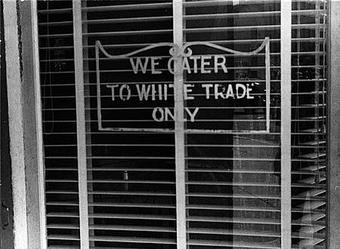
Segregation
A store catering to “whites only” under the separate but equal doctrine.
After the end of Reconstruction in 1877, former slave-holding states enacted various laws to undermine the equal treatment of African Americans, although the 14th Amendment, as well as federal Civil Rights laws enacted after the Civil War, were meant to guarantee such treatment. Southern states contended that the requirement of equality could be met in a manner that kept the races separate. Furthermore, the state and federal courts tended to reject the pleas by African Americans that their 14th Amendment rights had been violated, arguing that the 14th amendment applied only to federal, not state, citizenship.
The doctrine of “separate but equal” was legitimized in the 1896 Supreme Court case, Plessy v. Ferguson. Homer Plessy, who was of mixed ancestry, claimed that his constitutional rights had been violated when he was forced to move to a “colored’s only car” while riding a train. Nonetheless, the Supreme Court ruling “[required] railway companies carrying passengers in their coaches in that State to provide equal, but separate, accommodations for the white and colored races…,” establishing the actual term “separate but equal” in the process. After this ruling, not only was “separate but equal” applied to railroad cars, but also schools, voting rights and drinking fountains. Segregated schools were created for students, as long as they followed “separate but equal”.
Although the Constitutional doctrine required equality, the facilities and social services offered to African-Americans were almost always of lower quality than those offered to white Americans. For example, many African-American schools received less public funding per student than nearby white schools. In Texas, the state established a state-funded law school for white students without any law school for black students.
The repeal of such laws establishing racial segregation, generally known as Jim Crow laws, was a key focus of the Civil Rights Movement prior to 1954. The doctrine of “separate but equal” was eventually overturned by the Linda Brown v. Board of Education Supreme Court Case in 1954.
5.2.2: Brown v. Board of Education and School Integration
Brown v. Board of Education was a Supreme Court case which declared racial segregation in public schools unconstitutional.
Learning Objective
Summarize the phenomena of de jure and de facto segregation in the United States during the mid-1900s and the significance of the Brown v. Board of Education decision for the Civil Rights Movement
Key Points
- Brown v. Board of Education overturned the Plessy v. Ferguson decision of 1896 which allowed state-sponsored segregation.
- The plaintiffs argued that systematic racial segregation, while masquerading as providing separate but equal treatment of both white and black Americans, instead perpetuated inferior accommodations, services, and treatment for black Americans.
- The key holding of the Court was that, even if segregated black and white schools were of equal quality in facilities and teachers, segregation by itself was socially and psychologically harmful to black students and therefore unconstitutional.
Key Term
- de jure
-
By right, in accordance with the law, legally.
Brown v. Board of Education was a landmark U.S. Supreme Court case in which the Court declared that state laws establishing separate public schools for black and white students were unconstitutional. The decision overturned the Plessy v. Ferguson decision of 1896 that allowed state-sponsored segregation. Handed down on May 17, 1954, the Court’s unanimous (9–0) decision stated that “separate educational facilities are inherently unequal. ” As a result, de jure racial segregation was ruled a violation of the Equal Protection Clause of the Fourteenth Amendment of the U.S. Constitution. This ruling paved the way for further racial integration and was a major victory of the civil rights movement.
In 1951, a class action suit was filed against the Board of Education of Topeka, Kansas in the U.S. District Court for the District of Kansas. The plaintiffs were 13 Topeka parents who, on behalf of their 20 children, called for the school district to reverse its policy of racial segregation. The plaintiffs argued that systematic racial segregation, while seeming to provide separate but equal treatment of both white and black Americans, instead perpetuated inferior accommodations, services, and treatment for black Americans. The lead plaintiff was Oliver L. Brown, whose daughter Linda had to walk six blocks to her school bus stop to ride to Monroe Elementary, her segregated black school one mile away, while Sumner Elementary, a white school, was only seven blocks from her house.
The District Court ruled in favor of the Board of Education, citing the U.S. Supreme Court precedent set in Plessy v. Ferguson, and the case moved to the Supreme Court. Chief Justice Earl Warren convened a meeting of the justices and presented to them with the argument that the only reason to sustain segregation was an honest belief in the inferiority of African-American citizens. Warren further submitted that the Court must overrule Plessy to maintain its legitimacy as an institution of liberty, and it must do so unanimously to avoid massive southern resistance. Warren drafted the basic opinion and kept circulating and revising it until the opinion was endorsed by all the members of the Court.
Eventually, the key decision of the Court was that even if segregated black and white schools were of equal quality in facilities and teachers, segregation by itself was socially and psychologically harmful to black students and, therefore, unconstitutional. This aspect was vital because the question was not whether the schools were “equal,” which under Plessy they nominally should have been, but whether the doctrine of separate was constitutional.
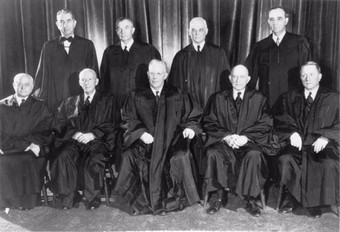
The Warren Court
The members of the Warren Court that unanimously agreed on Brown v. Board of Education.
5.2.3: Jim Crow and the Civil Rights Movement
The Civil Rights Movement aimed to outlaw racial discrimination against black Americans, particularly in the South.
Learning Objective
Differentiate between the legal strategies and “direct action” approaches used to challenge racial discrimination
Key Points
- Characteristics of the Jim Crow system included racial segregation, voter disenfranchisement, economic exploitation, and organized violence against the black community.
- After the Brown v. Board of Education decision in 1954, civil rights organization broadened their strategy to emphasize “direct action”—primarily boycotts, sit-ins, Freedom Rides, marches and similar tactics that relied on mass mobilization, nonviolent resistance and civil disobedience.
- Key events in the Civil Rights Movement included: the Montgomery Bus Boycott, the desegregation of Little Rock Central High School, student sit-ins, Freedom Rides, voter registration drives, and the March on Washington.
Key Terms
- desegregation
-
the act or process of ending the separation of two groups, usually referring to race
- disenfranchisement
-
Explicit or implicit revocation of, or failure to grant the right to vote, to a person or group of people.
The African American Civil Rights Movement refers to the social movements in the United States aimed at outlawing racial discrimination against black Americans and restoring voting rights to them. The Civil Rights Movement generally lasted from 1955 to 1968 and was particularly focused in the American South.
After the period of Reconstruction, the American South maintained an entrenched system of overt, state-sanctioned racial discrimination and oppression. Characteristics of this system, also known as “Jim Crow,” included racial segregation, voter disenfranchisement, economic exploitation, and organized violence against the black community. African Americans and other racial minorities resisted this regime in numerous ways and sought better opportunities through lawsuits, new organizations (such as the National Association for the Advancement of Colored People), political redress, and labor organizing.
After the Brown v. Board of Education decision in 1954, civil rights organization broadened their strategy to emphasize “direct action”—primarily boycotts, sit-ins, Freedom Rides, marches and similar tactics that relied on mass mobilization, nonviolent resistance and civil disobedience. This mass action approach typified the movement from 1960 to 1968. Churches, local grassroots organizations, fraternal societies, and black-owned businesses mobilized volunteers to participate in broad-based actions. This was a more direct and potentially more rapid means of orchestrating change than the traditional approach of mounting court challenges.
Key events in the Civil Rights Movement included: the Montgomery Bus Boycott (1955-1956), which began when Rosa Parks, a NAACP secretary, was arrested when she refused to cede her public bus seat to a white passenger; the desegregation of Little Rock Central High School (1957); the Selma to Montgomery marches, also known as Bloody Sunday and the two marches that followed, were marches and protests held in 1965 that marked the political and emotional peak of the American civil rights movement which sought to secure voting rights for African-Americans. All three were attempts to march from Selma to Montgomery where the Alabama capitol is located. The student sit-ins protesting segregated lunch counters (1960); the Freedom Rides (1961) in which activists attempted to integrate bus terminals, restrooms, and water fountains; voter registration drives; and the March on Washington for Jobs and Freedom (1963), in which civil rights leader, Martin Luther King, Jr. delivered his famous “I Have a Dream” speech.
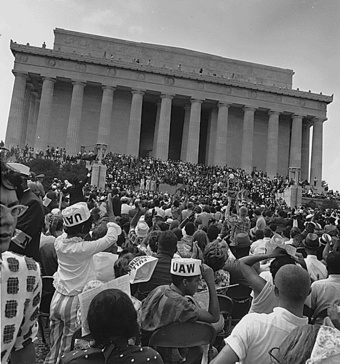
The March on Washington
The March on Washington, a key event in the U.S. Civil Rights Movement.
5.2.4: The Civil Rights Acts
The Civil Rights Act of 1964 outlawed forms of discrimination against women and minorities.
Learning Objective
Compare and contrast the 1964 Civil Rights Act and the 1965 Voting Rights Act
Key Points
- President John F. Kennedy called for the passage of the bill, though it was President Lyndon Johnson who would sign the bill into law after Kennedy’s assassination.
- The Civil Rights Act of 1964 emulated the Civil Rights Act of 1875, which established equal treatment in public accommodations.
- The Voting Rights Act of 1965 outlawed discriminatory voting practices responsible for the widespread disenfranchisement of African-Americans.
Key Terms
- civil rights
-
legal or moral entitlements which are expressly enumerated in the U.S. Constitution and are considered to be unquestionable, deserved by all people under all circumstances, especially without regard to race, creed, religion, sexual orientation, gender and disabilities
- Civil Rights Act of 1964
-
a landmark piece of legislation outlawing major forms of discrimination against women as well as minorities.
- Attorney General
-
the head of the United States Department of Justice; concerned with legal affairs as the chief law enforcement officer of the United States government.
The Civil Rights Act of 1964 was a landmark piece of United States legislation outlawing major forms of discrimination against women as well as racial, ethnic, national and religious minorities. It ended unequal application of voter registration requirements and racial discrimination in schools, at the workplace, and by facilities that served the general public.
In a civil rights speech on June 11, 1963, President John F. Kennedy called for passage of the bill, which he said would “give all Americans the right to be served in facilities which are open to the public – hotels, restaurants, theaters, retail stores, and similar establishments,” as well as “greater protection for the right to vote. ” Emulating the Civil Rights Act of 1875, which established equal treatment in public accommodations, Kennedy’s civil rights bill included provisions to ban discrimination in public accommodations. It also enabled the U.S. Attorney General to join in lawsuits against state governments which operated segregated school systems. After Kennedy’s assassination in November 1963, President Lyndon Johnson utilized his experience in legislative politics to garner support for the bill, which was passed in July 1964.
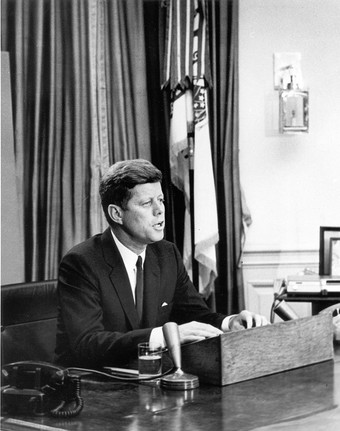
President John F. Kennedy
President John F. Kennedy, who called for the passage of a civil rights bill.
The Civil Rights Act was followed by the Voting Rights Act, signed into law by President Johnson in 1965. The Voting Rights Act outlawed discriminatory voting practices that had been responsible for the widespread disenfranchisement of African-Americans. Specifically, the Act outlawed the practice of requiring otherwise qualified voters to pass literary tests to register to vote. This was a principal means by which Southern states had prevented African-Americans from exercising the franchise.
The Voting Rights Act of 1965 is a landmark piece of national legislation in the United States that prohibits discrimination in voting. Echoing the language of the 15th Amendment, the Act prohibits states and local governments from imposing any “voting qualification or prerequisite to voting, or standard, practice, or procedure … to deny or abridge the right of any citizen of the United States to vote on account of race or color. ” Specifically, Congress intended the Act to outlaw the practice of requiring otherwise qualified voters to pass literacy tests in order to register to vote, a principal means by which Southern states had prevented African Americans from exercising the franchise. The Act was signed into law by President Lyndon B. Johnson, who had earlier signed the landmark Civil Rights Act of 1964 into law.
The Act established extensive federal oversight of elections administration, providing that states and local governments with a history of discriminatory voting practices could not implement any change affecting voting without first obtaining the approval of the Department of Justice, a process known as preclearance. The Act allowed “poll watchers” to ensure state compliance with federal legislation. It also eliminated literacy tests as a precondition for voting, effectively removing barriers to African American voter registration. These enforcement provisions applied to states and political subdivisions (mostly in the South) that had used a “device” to limit voting and in which less than 50 percent of the population was registered to vote in 1964. The Act has been renewed and amended by Congress four times, the most recent being a 25-year extension signed into law by President George W. Bush in 2006.
5.2.5: Continuing Challenges in Race Relations in the U.S.
The Civil Rights Movement influenced racial integration, but tensions with affirmative action and racism still affect racial relations.
Learning Objective
Explain why racial profiling remains controversial
Key Points
- Affirmative action refers to policies that take factors including race, color, religion, gender, sexual orientation, or national origin into consideration in order to benefit underrepresented groups in areas of employment, education, and business.
- Opponents emphasize that affirmative action is counterproductive, as choosing people based on their social group instead of solely their qualifications has the effect of devaluing their accomplishments.
- Racial profiling refers to the use of an individual’s race or ethnicity by law enforcement personnel as a key factor in deciding whether to engage in enforcement.
- After Richard Nixon’s inauguration in 1969, he appointed Vice President Agnew to lead a task force, which worked with local leaders—both white and black—to determine how to integrate local schools.
- Supporters of affirmative action often cite their goals as bridging inequalities in employment and pay; increasing access to education; enriching state, institutional, and professional leadership with the full spectrum of society; and redressing apparent past wrongs, harms, or hindrances.
Key Term
- reverse discrimination
-
The policy or practice of discriminating against members of a designated group which has in the past unfairly received preferential treatment in social, legal, educational, or employment situations, with the intention of benefiting one or more other groups (such as racial, disabled, or gender groups) that have previously been discriminated against.
Continuing Challenges
Background
Though much progress has been made in establishing racial equality since the time of the Civil Rights Movement, there still exist numerous challenges in this area. Two issues relating to race that remain controversial are the debates surrounding affirmative action and racial profiling.
Affirmative action refers to policies that take factors including race, color, religion, gender, sexual orientation, or national origin into consideration in order to benefit underrepresented groups in areas of employment, education, and business. In 1965, President Lyndon Johnson signed Executive order 11246, affirming the Federal Government’s commitment “to promote the full realization of equal employment opportunity through a positive, continuing program in each executive department and agency. “

President Lyndon B. Johnson
Lyndon B. Johnson, who successfully utilized negative political advertising in the famous “Daisy ad” during the 1964 election
After Richard Nixon’s inauguration in 1969, he appointed Vice President Agnew to lead a task force, which worked with local leaders—both white and black—to determine how to integrate local schools. Agnew had little interest in the work, and Labor Secretary George Shultz did most of it. Federal aid was available, and a meeting with President Nixon was a possible reward for compliant committees. By September 1970, fewer than ten percent of black children were attending segregated schools. By 1971, however, tensions over desegregation surfaced in Northern cities, with angry protests over the busing of children to schools outside their neighborhood to achieve racial balance. Nixon opposed busing personally but enforced court orders requiring its use.
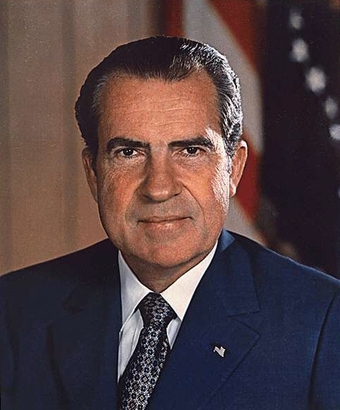
Richard Nixon, 37th President of the United States
Richard Nixon was elected president in 1968, and resigned in 1974 amidst the Watergate scandal. His presidency included foreign policy achievements, most notably improved relations with China.
In addition to desegregating public schools, Nixon implemented the Philadelphia Plan in 1970—the first significant federal affirmative action program. He also endorsed the Equal Rights Amendment after it passed both houses of Congress in 1972 and went to the states for ratification. Nixon had campaigned as an ERA supporter in 1968. However, feminists criticized him for doing little to help the ERA or their cause after his election even though he appointed more women to administration positions than Lyndon Johnson had.
Racial Profiling
Racial profiling refers to the use of an individual’s race or ethnicity by law enforcement personnel as a key factor in deciding whether to engage in enforcement (e.g. make a traffic stop or arrest). The practice is controversial and illegal in many jurisdictions. Racial profiling is challenged at a federal level by both the 4th Amendment of the U.S. Constitution, which guarantees the right to be safe from search and seizure without a warrant (which is to be issued “upon probable cause”); and the 14th Amendment, which requires that all citizens be treated equally under the law. Nonetheless, racial profiling is sometimes practiced in African-American, Hispanic, and Muslim communities within the U.S.
Today’s Controversy of Affirmative Action
The controversy surrounding affirmative action’s effectiveness is based on the idea of class inequality. Opponents of racial affirmative action argues that the program actually benefits middle and upper class African Americans and Hispanic Americans at the expense of lower-income European Americans and Asian Americans. This argument supports the idea of solely class-based affirmative action. America’s poor is disproportionately made up of people of color, so class-based affirmative action would disproportionately help people of color. This would eliminate the need for race-based affirmative action as well as reducing any disproportionate benefits for middle and upper class people of color.
Supporters of affirmative action often cite their goals as
- bridging inequalities in employment and pay;
- increasing access to education;
- enriching state, institutional, and professional leadership with the full spectrum of society;
- redressing apparent past wrongs, harms, or hindrances.
Opponents emphasize that affirmative action is counterproductive. They believe that choosing people based on their social group instead of solely their qualifications has the effect of devaluing their accomplishments; opponents also claim that affirmative action is a form of “reverse discrimination” and may increase racial tension.
5.3: Women’s Rights
5.3.1: The Women’s Rights Movement
The women’s rights movement refers to political struggles to achieve rights claimed for women and girls of many societies worldwide.
Learning Objective
Compare and contrast the first and second waves of feminism in the United States
Key Points
- Second-wave feminism is a period of feminist activity that broadened the debate to a wide range of issues: sexuality, family, the workplace, reproductive rights, de facto inequalities, and official legal inequalities.
- The second wave of feminism in North America came as a delayed reaction against the renewed domesticity of women after World War II: the late 1940s post-war boom, which was an era characterized by unprecedented economic growth, a baby boom, and the move to family-oriented suburbs.
- In 1963, Betty Friedan wrote the bestselling book “The Feminine Mystique” in which she explicitly objected to the mainstream media image of women, stating that placing women at home limited their possibilities, and wasted talent and potential.
- The changing of social attitudes towards women is usually considered the greatest success of the women’s movement.
Key Terms
- Roe v. Wade
-
Roe v. Wade (1973) is a landmark decision by the United States Supreme Court on the issue of abortion; the Court ruled 7-2 that a right to privacy under the due process clause of the 14th Amendment extended to a woman’s decision to have an abortion, but that right must be balanced against the state’s two legitimate interests in regulating abortions: protecting prenatal life and protecting women’s health. Arguing that these state interests became stronger over the course of a pregnancy, the Court resolved this balancing test by tying state regulation of abortion to the trimesters of pregnancy.
- Betty Friedan
-
In 1963, Betty Friedan wrote the bestselling book “The Feminine Mystique” in which she explicitly objected to the mainstream media image of women, stating that placing women at home limited their possibilities, and wasted talent and potential.
- Second-Wave Feminism
-
Second-wave feminism is a period in the history of feminism in America that broadened the debate to a wide range of issues: sexuality, family, the workplace, reproductive rights, de facto inequalities, and official legal inequalities.
Example
- By the early 1980s, it was largely perceived that women had met their goals and succeeded in changing social attitudes towards gender roles, repealing oppressive laws that were based on sex, integrating “boys’ clubs” such as military academies, the United States Armed Forces, NASA, single-sex colleges, men’s clubs, and the Supreme Court, and by accomplishing the goal of making gender discrimination illegal.
Introduction
Second-wave feminism is a period of feminist activity. In the United States, second-wave feminism, initially called the Women’s Liberation Movement , began during the early 1960s and lasted through the late 1990s. It was a worldwide movement that was strong in Europe and parts of Asia, such as Turkey and Israel, where it began in the 1980s, and it began at other times in other countries.
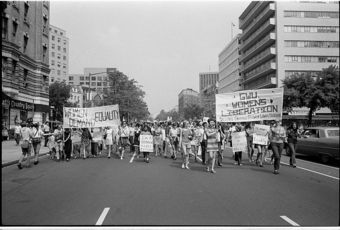
Women’s Liberation March
Women’s Liberation march from Farrugut Square to Layfette park
Whereas first-wave feminism focused mainly on suffrage and overturning legal obstacles to gender equality (i.e. voting rights, property rights), second-wave feminism broadened the debate to a wide range of issues: sexuality, family, the workplace, reproductive rights, de facto inequalities, and official legal inequalities. At a time when mainstream women were making job gains in professions, the military, the media, and sports in large part because of second-wave feminist advocacy, second-wave feminism also focused on a battle against violence with proposals for marital rape laws, establishment of rape crisis and battered women’s shelters, and changes in custody and divorce law. Its major effort was trying to get the Equal Rights Amendment (ERA) added to the United States Constitution, an effort in which they were defeated by anti-feminists led by Phyllis Schlafly, who argued against the ERA, saying women would be drafted into the military.
Historical Precedents
Starting in the late 18th century, and throughout the 19th century, rights, as a concept and claim, gained increasing political, social and philosophical importance in Europe. Movements emerged which demanded freedom of religion, the abolition of slavery, rights for women, rights for those who did not own property and universal suffrage. In the late 18th century the question of women’s rights became central to political debates in both France and Britain. At the time some of the greatest thinkers of the Enlightenment, who defended democratic principles of equality and challenged notions that a privileged few should rule over the vast majority of the population, believed that these principles should be applied only to their own gender and their own race.
Overview
The second wave of feminism in North America came as a delayed reaction against the renewed domesticity of women after World War II: the late 1940s post-war boom, which was an era characterized by an unprecedented economic growth, a baby boom, a move to family-oriented suburbs, and the ideal of companionate marriages. This life was clearly illustrated by the media of the time; for example, television shows such as “Father Knows Best” and “Leave It to Beaver” idealized domesticity.
In 1960, the Food and Drug Administration approved the combined oral contraceptive pill, which was made available in 1961. This made it easier for women to have careers without having to leave due to unexpectedly becoming pregnant. The administration of President Kennedy made women’s rights a key issue of the New Frontier, and named women (such as Esther Peterson) to many high-ranking posts in his administration.
In 1963 Betty Friedan (), influenced by Simone De Beauvoir’s book “The Second Sex,” wrote the bestselling book “The Feminine Mystique” in which she explicitly objected to the mainstream media image of women, stating that placing women at home limited their possibilities, and wasted talent and potential. The perfect nuclear family image depicted and strongly marketed at the time, she wrote, did not reflect happiness and was rather degrading for women. This book is widely credited with having begun second-wave feminism.

Betty Friedan (1960)
Betty Friedan, American feminist and writer, wrote the best selling book “The Feminist Mystique. ” This book is widely credited with having begun second-wave feminism in the United States.
Achievements
Among the most significant legal victories of the movement after the formation of the National Organization of Women (NOW) were: a 1967 Executive Order extending full Affirmative Action rights to women, Title IX and the Women’s Educational Equity Act (1972 and 1974, respectively, educational equality), Title X (1970, health and family planning), the Equal Credit Opportunity Act (1974), the Pregnancy Discrimination Act of 1978, the outlaw of marital rape, the legalization of no-fault divorce, a 1975 law requiring U.S. Military Academies to admit women, and many Supreme Court cases, perhaps most notably Reed v. Reed of 1971 and Roe v. Wade of 1973 . However, the changing of social attitudes towards women is usually considered the greatest success of the women’s movement.
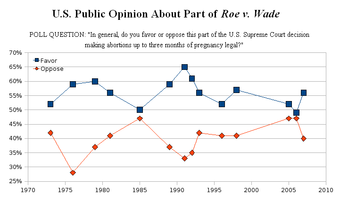
U.S. Public Opinion about Roe v. Wade
Graph showing public support for Roe v. Wade over the years
By the early 1980s, it was largely perceived that women had met their goals and succeeded in changing social attitudes towards gender roles, repealing oppressive laws that were based on sex, integrating “boys’ clubs” such as military academies, the United States Armed Forces, NASA, single-sex colleges, men’s clubs, and the Supreme Court, and by accomplishing the goal of making gender discrimination illegal. However, the movement did fail, in 1982, in adding the Equal Rights Amendment to the United States Constitution, coming up three states short of ratification.
5.3.2: Gender Discrimination
Gender discrimination refers to prejudice or discrimination based on gender, as well as conditions that foster stereotypes of gender roles.
Learning Objective
Illustrate cases of gender discrimination and stereotypes
Key Points
- Sexist attitudes are frequently based on beliefs in traditional stereotypes of gender roles, and is thus built into many societal institutions.
- Many of the stereotypes that result in gender discrimination are not only descriptive, but also prescriptive beliefs about how men and women “should” behave.
- Occupational sexism refers to discriminatory practices, statements, or actions based on a person’s gender which occur in a place of employment.
- Violence against women, including sexual assault, domestic violence, and sexual slavery, remains a serious problem around the world.
Key Terms
- objectification
-
The process or manifestation of objectifying (something).
- Gender Role
-
a set of social and behavioral norms that are generally considered appropriate for either a man or a woman in a social or interpersonal relationship.
- stereotype threat
-
the experience of anxiety or concern in a situation where a person has the potential to confirm a negative stereotype about their social group.
Gender discrimination, also known as sexism, refers to prejudice or discrimination based on sex and/or gender, as well as conditions or attitudes that foster stereotypes of social roles based on gender. Sexist mindsets are frequently based on beliefs in traditional stereotypes of gender roles, and is thus built into many societal institutions.
Gender Stereotypes
Gender stereotypes are widely held beliefs about the characteristics and behavior of women and men. Many of the stereotypes that result in gender discrimination are not only descriptive, but also prescriptive beliefs about how men and women “should” behave. For example, women who are considered to be too assertive or men who lack physical strength are often criticized and historically faced societal backlash. They can also facilitate or impede intellectual performance, such as the stereotype threat that lower women’s performance on mathematics tests, due to the stereotype that women have inferior quantitative skills compared to men’s, or when the same stereotype leads men to assess their own task ability higher than women performing at the same level.

Gender stereotypes
A poster depicting gender stereotypes about women drivers from the 1950s
Examples of Gender Discrimination
There are several prominent ways in which gender discrimination continues to play a role in modern society. Occupational sexism refers to discriminatory practices, statements, and/or actions based on a person’s gender which occur in a place of employment. Wage discrimination, the “glass ceiling” (in which gender is perceived to be a barrier to professional advancement), and sexual harassment in the workplace are all examples of occupational sexism. Violence against women, including sexual assault, domestic violence, and sexual slavery, remains a serious problem around the world. Many also argue that the objectification of women, such as in pornography, also constitutes a form of gender discrimination.
5.3.3: The Women’s Suffrage Movement
The Women’s Suffrage Movement refers to social movements around the world dedicated to achieving voting rights for women.
Learning Objective
Discuss the historical events that culminated with women’s suffrage in America
Key Points
- Within the United States, the first major call for women’s suffrage took place in 1848 at the Seneca Falls Convention.
- World War I provided the final push for women’s suffrage in America, as President Wilson’s stance that the war was being fought for democracy was countered by those who felt women’s disenfranchisement prevented America from being a true democracy.
- In 1919, the Senate passed the Nineteenth Amendment, giving women the right to vote, though the amendment would not be fully ratified until 1920.
- Through a constitutional amendment, reformers pursued state-by-state campaigns to build support for, or to win, residence-based state suffrage. Towns, counties, states, and territories granted suffrage, in full or in part, throughout the 19th and early 20th century.
Key Terms
- Progressive Era
-
a period of social activism and political reform in the United States that flourished from the 1890s to the 1920s.
- suffrage
-
To have the right to vote by citizens of a particular state.
- Prohibition
-
A law prohibiting the manufacture or sale of alcohol.
Background
The Women’s Suffrage Movement refers to social movements around the world dedicated to achieving voting rights for women. Within the United States, the first major call for women’s suffrage took place in 1848 at the Seneca Falls Convention. After the Civil War agitation for the cause resumed. In 1869, the Fifteenth Amendment of the Constitution which gave black men the right to vote, split the movement. Campaigners such as Susan B. Anthony and Elizabeth Cady Stanton refused to endorse the amendment, as it did not give women the right to vote. Others, such as Lucy Stone and Julia Ward Howe, argued that if black men were enfranchised, it would help women achieve their goal.
The conflict caused two organizations to emerge, the National Woman Suffrage Association, which campaigned for women’s suffrage at a federal level and for married women to be given property rights. As well as the American Woman Suffrage Organization, which aimed to secure women’s suffrage through state legislation. After 1900, the groups made a new argument to the effect that women’s superior characteristics, especially purity, made their votes essential to promoting the reforms of the Progressive Era, particularly Prohibition, and exposing political corruption .
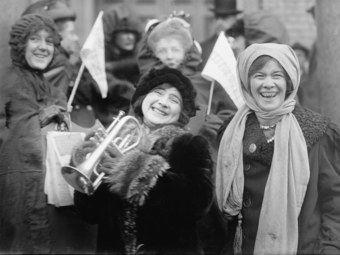
Women’s Suffrage
Supporters of women’s suffrage at a political rally
Women’s Suffrage in America
World War I provided the final push for women’s suffrage in America. When President Woodrow Wilson announced that the war was being fought for democracy, supporters of women’s suffrage protested that disenfranchising women prevented the United States from being a true democracy. In 1918, after years of opposition, Wilson changed his position to advocate for women’s suffrage as a war measure.
In June 1919, the Nineteenth Amendment to the Constitution, giving women the right to vote, was brought before the Senate, and after a long discussion it was passed, with 56 ayes and 25 nays. It would take until August 1920 for enough state legislatures to ratify the amendment, thus making it the law throughout the United States.
In addition to their strategy to obtain full suffrage through a constitutional amendment, reformers pursued state-by-state campaigns to build support for, or to win, residence-based state suffrage. Towns, counties, states, and territories granted suffrage, in full or in part, throughout the 19th and early 20th century. As women received the right to vote, they began running for, and being elected to, public office. They gained positions as school board members, county clerks, state legislators, judges, and eventually as Members of Congress.
5.3.4: The Feminist Movement
The feminist movement refers to a series of campaigns for cultural, political, economic, and social equality for women.
Learning Objective
Compare and contrast the three waves of feminism in the United States and their historical achievements
Key Points
- The history of feminist movements has been divided into three “waves” by feminist scholars.
- The first wave focused on women’s suffrage; the second wave (early 1960s to the late 1980s) was concerned with cultural and political inequalities. The third wave, (starting in the 1990s) criticizes definitions of femininity that generalize the experiences of upper-middle-class white women.
- As a whole, the feminist movement affected change in Western society, including women’s suffrage, the right to initiate divorce proceedings and “no fault” divorce, the right of women to make individual decisions regarding pregnancy, and the right to own property.
- Other important advances in the women’s movement include the founding of the National Organization for Women, as well as the development of legislation prohibiting sexual harassment or discrimination based on gender.
- While women have made strides, they still fall behind men in important measures. They are still underrepresented in Congress, and overrepresented in what have traditionally been considered “women’s” professions (such as teachers or secretaries).
- In recent times, many American women have accomplished “firsts” in the 2000s. For instance, Nancy Pelosi became the first woman to serve as Speaker of the House.
Key Terms
- feminist movement
-
The feminist movement refers to a series of campaigns for reforms on issues. such as reproductive rights, domestic violence, maternity leave, equal pay, women’s suffrage, sexual harassment, and sexual violence.
- National Organization for Women
-
The largest feminist organization in the United States. It was founded in 1966 and has 500,000 contributing members. The six core issues that NOW addresses are abortion rights/reproductive issues, violence against women, constitutional equality, promoting diversity/ending racism, lesbian rights, and economic justice.
- Equal Employment Opportunity Commission
-
A federal law enforcement agency that enforces laws against workplace discrimination. The EEOC investigates discrimination complaints based on an individual’s race, color, national origin, religion, sex, age, disability, genetic information, and retaliation for opposing a discriminatory practice.
The Feminist Movement
The feminist movement (also known as the women’s movement or women’s liberation) refers to a series of campaigns for reforms on issues, such as women’s suffrage, reproductive rights, domestic violence, maternity leave, equal pay in the workplace, maternity leave, sexual harassment, and sexual violence. The movement’s priorities vary among nations and communities.
Women constitute a majority of the population and of the electorate in the United States, but they have never spoken with a unified voice for civil rights, nor have they received the same degree of protection as racial and ethnic minorities.
History of the Movement
The history of feminist movements has been divided into three “waves” by feminist scholars. The first wave refers to the feminist movement of the nineteenth through early twentieth centuries, which focused mainly on women’s suffrage .
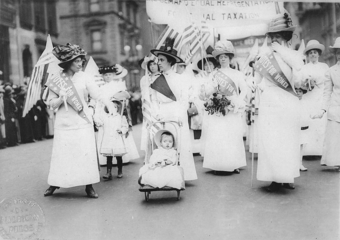
Feminist Suffrage Parade in New York City, May 6, 1912.
First-wave feminists marching for women’s suffrage. The first wave of women’s feminism focused on suffrage, while subsequent feminist efforts have expanded to focus on equal pay, reproductive rights, sexual harassment, and others.
The second wave, generally taking place from the early 1960s to the late 1980s, was concerned with cultural and political inequalities, which feminists perceived as being inextricably linked. The movement encouraged women to understand aspects of their own personal lives as deeply politicized and reflective of a sexist structure of power.
The third wave, starting in the 1990s, rose in response to the perceived failures of the second wave feminism. It seeks to challenge or avoid what it deems the second wave’s “essentialist” definitions of femininity, which often assumed a universal female identity and over-emphasized the experiences of upper-middle-class white women.
One of the most important organizations that formed out of the women’s rights movement is the National Organization for Women (NOW). Established in 1966 and currently the largest feminist organization in the United States, NOW works to secure political, professional, and educational equality for women. In 1972, NOW and other women activist groups fought to ratify the Equal Rights Amendment (ERA) to the Constitution, which affirmed that women and men have equal rights under the law. Although passage failed, the women’s rights movement has made significant inroads in reproductive rights, sexual harassment law, pay discrimination, and equality of women’s sports programs in schools.
In 1980, the Equal Employment Opportunity Commission defined sexual harassment as unwelcome sexual advances or sexual conduct, verbal or physical, that interferes with a person’s performance or creates a hostile working environment. Such discrimination on the basis of sex is barred in the workplace by the Civil Rights Act of 1964 and in colleges and universities that receive federal funds by Title IX. In a series of decisions, the Supreme Court has ruled that employers are responsible for maintaining a harassment-free workplace. Legislation such as this has helped to protect the rights of women in the workplace and at schools. The proposed ERA did have unintended consequences. For example, stay-at-home women did not agreed necessarily with women who worked steady schedules.
The Status of Women in the United States
As a whole, the feminist movement has brought changes to U.S. society, including women’s suffrage, the right to initiate divorce proceedings and “no fault” divorce, the right of women to make individual decisions regarding pregnancy (including access to contraceptives and abortion), and the right to own property. It has also led to increased employment opportunities for women at more equitable wages, as well as broad access to university educations. The feminist movement also helped to transform family structures as a result of these increased rights, in that gender roles and the division of labor within households have gradually become more flexible.
Marxist Feminism
Rosemary Hennessy and Chrys Ingraham say that materialist feminisms grew out of Western Marxist thought and have inspired a number of different (but overlapping) movements, all of which are involved in a critique of capitalism and are focussed on ideology’s relationship to women. Marxist feminism argues that capitalism is the root cause of women’s oppression, and that discrimination against women in domestic life and employment is an effect of capitalist ideologies. Socialist feminism distinguishes itself from Marxist feminism by arguing that women’s liberation can only be achieved by working to end both the economic and cultural sources of women’s oppression. Anarcha-feminists believe that class struggle and anarchy against the state.
Despite this, many American women achieved many political firsts in the 2000s. In 2007, Nancy Pelosi became the first female Speaker of the House of Representatives. In 2008, Democratic presidential candidate Hillary Clinton became the first woman to win a presidential primary, winning the New Hampshire Democratic primary . In 2008, Alaska governor Sarah Palin became the first woman nominated for Vice President by the Republican Party. In 2009 and 2010, respectively, Sonia Sotomayor and Elena Kagan were confirmed as Supreme Court Associate Justices, making them the third and fourth female justices.

Hillary Rodham Clinton
While women still fall behind men in many important measures, important exceptions exist. For example, Hillary Clinton became the first woman to become the presumptive nominee of a major political party.
5.3.5: Women in the Workplace
Women’s participation in the workforce has been a relatively recent phenomenon and is still associated with many continuing challenges.
Learning Objective
Identify the barriers for equal participation of women in the workplace
Key Points
- Particular barriers to equal participation in the workplace included a lack of access to educational opportunities; restrictions women entering or studying a field; discrimination within a field; and the expectation that mothers should be the primary childcare providers.
- Beginning in the 1970s, women began attending colleges and graduate schools in large numbers and entering professions like law, medicine, and business.
- Challenges that remain for women in the workplace include the gender pay gap, the “glass ceiling”, sexual harassment, and network discrimination.
Key Terms
- sexual harassment
-
intimidation, bullying or coercion of a sexual nature, or the unwelcome or inappropriate promise of rewards in exchange for sexual favors.
- sexism
-
or gender discrimination is prejudice or discrimination based on a person’s sex or gender. Extreme sexism may foster sexual harassment, rape and other forms of violence.
Women’s participation in the workforce has been a relatively recent phenomenon. Until modern times, legal and cultural practices, combined with the inertia of longstanding religious and educational conventions, restricted women’s entry and participation in the workforce.
Particular barriers to equal participation in the workplace included a lack of access to educational opportunities; prohibitions or restrictions on members of a particular gender entering a field or studying a field; discrimination within fields, including wage, management, and prestige hierarchies; and the expectation that mothers, rather than fathers, should be the primary childcare providers.
Within the United States, World War I and World War II provided many new opportunities for women to participate in the workplace, including jobs as secretaries, salespeople, factory workers. Beginning in the 1970s, women began attending colleges and graduate schools in large numbers and entering professions like law, medicine, and business. Many scholars attribute this trend to the advent of the birth control pill, which allowed women to postpone pregnancy and marriage and focus instead on their education and careers. This transformation of women’s expectations had a profound effect on their conception of their own identity and still continues on today.
Challenges that remain for women in the workplace include the gender pay gap, the difference between women’s and men’s earnings due to lifestyle choices and explicit discrimination; the “glass ceiling”, which prevents women from reaching the upper echelons within their companies; sexism and sexual harassment; and network discrimination, wherein recruiters for high-status jobs are generally men who hire other men.
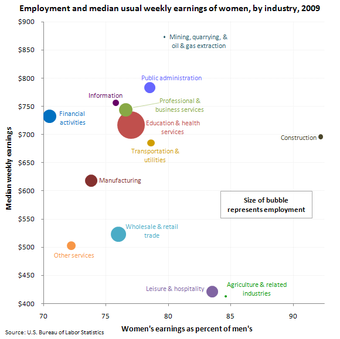
Gender pay gap
A chart depicting women’s earnings in different industries as a percentage of men’s earnings
5.3.6: Women in American Politics
In recent decades, women have served in more political posts and organizations, but they remain underrepresented in comparison to men.
Learning Objective
Analyze the role that women play in American politics, especially the involvement of African-American women in grassroots activism and institutional politics
Key Points
- As of January 2011, 35 women have served as governors of U.S. states, with six women currently serving.
- There are currently 17 female members of the Senate, 12 Democrats and 5 Republicans.
- The first woman to serve as a justice in the U.S. Supreme Court was Sandra Day O’Connor, who was appointed by President Ronald Reagan in 1981.
- African-American women have been involved in American political issues and advocating for the community since the American Civil War era through organizations, clubs, community-based social services, and advocacy.
- African-American women have been underrepresented in politics within the United States, but numbers still increase. The Center for American Women and Politics at Rutgers University states currently 13 African-American women serve in the 112th Congress, with 239 state legislators serving nationwide.
Key Terms
- misogyny
-
Hatred of, contempt for, or prejudice against women.
- U.S. Cabinet
-
The most senior appointed officers of the executive branch of the federal government of the United States, who are generally the heads of the federal executive departments.
Background
As women campaigned for and eventually received the right to vote, they began running for, and being elected to, public office. They gained positions as school board members, county clerks, state legislators, judges and, eventually, shortly before ratification of the Nineteenth Amendment, as members of Congress. In recent decades, women have been increasingly involved in American politics, serving as mayors, governors, state legislators, members of Congress, members of the U.S. Cabinet, and Supreme Court justices.
As of January 2011, 35 women have served as governors of U.S. states, with six women currently serving. The first elected female governor was Nellie Tayloe Ross of Wyoming, who was sworn in on November 4, 1925. The first female governor elected without being the wife or widow of a past state governor was Ella T. Grasso of Connecticut, sworn in on January 8, 1975.
Women in the Government Posts
The first woman elected to Congress was Jeannette Rankin, a Republican from Montana who took office in 1917. Women have been elected to the House of Representatives from 44 of the 50 states. Thirty-nine women have served altogether in the Senate, with Hattie Caraway of Arkansas became the first woman to win election to that legislative body in 1932. There are currently 17 female members of the Senate, 12 Democrats and 5 Republicans.
Twenty-five women have served as U.S. Cabinet officials. The first woman to hold a Cabinet position was Frances Perkins, who was appointed Secretary of Labor by President Franklin D. Roosevelt in 1933. Other prominent female Cabinet members include: Janet Reno, who served as the first female attorney general under President Bill Clinton; Madeline Albright, who served as the first female secretary of state under President Clinton; Condoleezza Rice, Secretary of State under President George W. Bush; and Hillary Rodham Clinton, former First Lady, Senator from New York, Secretary of State under Barack Obama, and the first woman to be nominated for president by a major American political party.

Hillary Rodham Clinton
While women still fall behind men in many important measures, important exceptions exist. For example, Hillary Clinton became the first woman to be nominated for president by a major American political party
The first woman to serve as a justice in the U.S. Supreme Court was Sandra Day O’Connor, who was appointed by President Ronald Reagan in 1981. Three women serve in the current Supreme Court: Ruth Bader Ginsburg, appointed by President Clinton; Sonia Sotomayor, appointed by President Obama; and Elena Kagan, also appointed by President Obama.
African American women in politics
African-American women have been involved in American political issues and advocating for the community since the American Civil War era through organizations, clubs, community-based social services, and advocacy. Issues that deal with identity, racism, and sexism have been important to African-American women in the political dialogue.
Though women obtained the right to vote in the United States in 1920, many women of color still ran into obstacles. Some faced tests that required them to interpret the Constitution in order to vote. Others were threatened with physical violence, false charges, and other extreme danger to prevent voting. Due to these tactics and others that marginalized people of color, the Voting Rights Act of 1965 was put into place. It outlawed any discriminatory acts to prevent people from voting.
Women and Black Power
Despite the fact that elements of the Black Power Movement had some views centered on misogyny, African-American women quickly found a voice in the movement. Women held leadership positions, ran community-based programs, and fought misogyny. Other women also contributed to the grass-roots movement through community service. “In the age of rights, antipoverty, and power campaigns, black women in community-based and often women-centered organizations, like their female counterparts in nationally known organizations, harnessed and engendered Black Power through their speech and iconography as participants of tenant councils, welfare rights groups, and a black female religious order.”
Political Representation
African-American women have been underrepresented in politics within the United States, but numbers continue to increase. According to the Center for American Women and Politics at Rutgers University, currently 13 African-American women serve in the 112th Congress, with 239 state legislators serving nationwide . The paths to public office for women in the African-American community have differed from men and other groups, such as women’s organizations, rallies, and fundraisers.
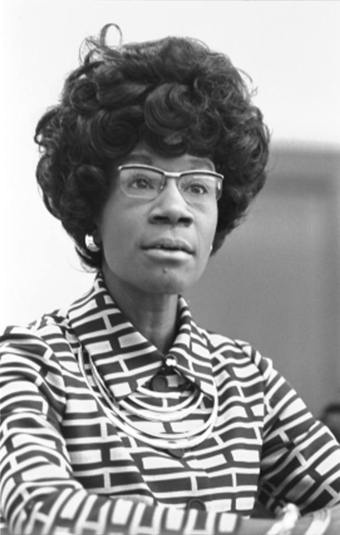
Shirley Chisholm
Shirley Chisholm was a member of the U.S. House of Representatives representing New York’s twelfth Congressional District for seven terms from 1969 to 1983.
A number of organizations supporting African-American women have historically played an important role in politics. The National Association of Colored Women, founded in 1896 by Josephine St. Pierre Ruffin and Mary Church Terrell, is one of the oldest political groups created for and by African-American women. Among its objectives were equal rights, eliminating lynching, and defeating Jim Crow laws. Another organization, the National Council of Negro Women, was founded in 1935 by civil rights activist Mary McLeod Bethune and was more involved in African-American politics with the aim to improve the quality of life for African-American women and families.
5.4: Civil Rights of Other Specific Groups
5.4.1: Civil Rights of Latinos
Policies regarding immigration, language, and voting are modern-day civil rights issues that affect Latinos living in the United States.
Learning Objective
Identify the recent trends in voting among Latinos in the United States and the civil rights issues that affect them
Key Points
- Since the mid-1960’s, Latinos have become the largest immigrant group to the United States.
- Immigration policy remains a highly controversial issue in U.S. politics, with proposals ranging from building a wall along the U.S./Mexican border to limit immigration, to granting legal status to all foreign-born Latinos currently working in the United States.
- Many Latinos living in the U.S. arguably face civil rights violations, such as policies that limit Latino voting and economic participation.
Key Terms
- redistricting
-
the process of drawing boundaries for United States electoral areas, often in response to population changes determined by the results of the decennial census
- Immigration and Nationality Act of 1965
-
Immigration legislation that removed yearly, numerical quotas based on the immigrant’s country of origin and implemented a system of ranking potential immigrants based on skills and family relationships.
- Latino
-
A term used in the U.S. to describe people of Latin American descent or origin.
Example
- Voting redistricting laws that serve to limit the political power of Latino voting blocs are examples of contemporary civil rights controversy affecting Latinos.
Introduction
“Latino” is a term used primarily in the United States to designate people of Latin American heritage or descent. Often, the term is treated as a synonym for Hispanic, although the latter only includes persons of Spanish-speaking origin. Latino is generally used more broadly to include non-Spanish speaking persons of Latin American descent, such as Brazilians. The U.S. Census considers Latino persons to share an ethnic group, not a race. Therefore, on the census individuals of any race can indicate that they are Hispanic or Latino.
Civil Rights and Immigration
The United States has long been a nation with a large immigrant population, but immigration policies have varied throughout the country’s history. In the earliest years, the largest immigrant group to North America consisted of European men. Immigration (not including the arrival of African and Caribbean slaves) proceeded at a relatively low rate until the mid-19th century. By the mid-1800’s, poor economic conditions in some European nations and a surge in industrial opportunities in the U.S. contributed to a dramatic rise in the number of immigrants entering the U.S. The wave of immigration in the latter half of the 1800’s was dominated by the Irish and Germans, although other European ethnicities arrived in significant numbers. By the early 1900’s, vast numbers of immigrants were still arriving, but the demographics had changed. Increasingly large numbers of southern and eastern Europeans were arriving in the eastern United States, while many Chinese and Japanese immigrants were arriving on the West Coast. In response, the U.S. government passed immigration quota laws in the 1920’s which restricted the number of people who could enter the U.S. from any given country. In effect, the policy changes restricted immigration from southern and eastern Europe, Asia, and Central and South America.
The immigration policies of the 1920’s stood until the passage of the Immigration and Nationality Act of 1965, also known as the Hart-Cellar Act. By the 1960’s, immigration was seen as a civil rights issue. Critics of existing policy included President John F. Kennedy, who considered immigration quotas to be at odds with democratic principles. The Immigration and Nationality Act of 1965 was signed into law by President Lyndon B. Johnson. It removed national-origin quotas from immigration law. Instead, potential immigrants would be ranked based on skills, education, and family relationships. The Hart-Cellar Act opened the borders to populations that had been largely excluded from entry to the U.S. in earlier years, thus shifting the demographics of the country. Prior to 1965 the majority of immigrants in the U.S. were of European descent, but in the subsequent decades Latinos came to make up a majority of new immigrants .

The American Public by Ancestry, 2000
Especially in the southwest United States, people of Latino origin make up a significant proportion of United States residents.
Since the Civil Rights Era legislation that made Latino immigration possible, debates about immigration law have remained controversial. In particular, immigration from Mexico has surged since the late-1980’s. People of Mexican origin are now the largest foreign-born group in the United States. While many Mexican and Latino immigrants enter the country legally, particularly through family reunification policies, a substantial number do not have legal-immigrant status — an estimated 700,000 new immigrants per year. Some politicians have sought legislation to curb the flow of immigration from Latin America, including a proposals for increased deportation, building a wall along the U.S./Mexican border, and harsher enforcement of existing laws. Many other politicians and voters instead seek to facilitate the acquisition of legal citizenship for current residents.
Contemporary immigration policy is widely considered to be a civil rights issue that disproportionately affects Latinos. Enforcement and labor policies often violate the rights that are afforded to U.S. citizens. For example, many Latino immigrants are employed in unregulated workplaces, where employers do not pay minimum wage and do not abide by health and safety regulations. Children of immigrants may be denied access to education or coerced into labor that violates child labor laws. Moreover, for fear of deportation or prosecution, immigrants without legal status do not have legal recourse when they are victims of crimes or exploitation. Current policy proposals aimed at reducing these rights violations include legislation to grant legal status to all children born in the U.S. as well as proposals for foreign worker programs that would grant legal status to foreign born laborers. These proposals are highly controversial among the U.S. electorate and politicians.
Language
Because the majority of foreign-born Latinos in the United States speak Spanish as a primary language, and many second-generation continue to speak Spanish in their households, controversies surrounding language are sometimes considered to be civil rights issues affecting Latinos. In recent decades, politicians have repeatedly proposed provisions to make English the official language of the U.S. These proposals have never passed — the U.S. does not have an official language. But, if such propositions were to become law, it would make it substantially more difficult for Spanish-speaking Americans to vote, attend school, and participate in other civic rights and duties. In many cases, critiques of proposals to make English the country’s official language accuse bill sponsors of attempting to disenfranchise Latinos — that is, of trying to reduce their political and economic power.
Voting
Proposals to change voting laws in recent years have also been met by criticism that they would prevent American Latinos from participating in the country’s governance. In some states, redistricting, or the process of redrawing voting precinct boundaries, has divided voters to either segregate Latinos or prevent them from gaining a majority in historically white native-born American districts. Similarly, recent proposals to require more stringent identification at polling places is suspected of attempting to reduce Latino voter turnout because a disproportionate number of Latino citizens do not have drivers licenses or other forms of state-accepted ID.
5.4.2: Civil Rights of Asian Americans
Civil Rights controversies surrounding Asian Americans include early immigration restrictions and xenophobia during the Second World War.
Learning Objective
Discuss the civil rights issues that affect Asian Americans
Key Points
- By the late 1800s, Asian American immigrants, especially from China, comprised large portions of the labor force in some industries.
- Throughout the early to mid-20th century, a period of xenophobia referred to as “Yellow Peril” saw limitations on Asian immigration and civil rights violations inflicted on U.S. Asian residents.
- Since the 1960s, Asian Americans have seen large advances in educational attainment and professional success, leading some commentators to refer to the group as the model minority.
Key Terms
- Yellow Peril
-
A period of xenophobia in the early 1900s that resulted in laws restricting the immigration and naturalization of people of Asian origin.
- internment camp
-
A governmental euphemism for a concentration camp, especially a non-Nazi one from before or during WWII; a detention center; a relocation camp.
- national origins quota laws
-
Immigration laws restricting the number of people who may legally enter the U.S. from any given country.
Example
- Internment camps during World War II were used to hold Japanese American residents and citizens, who were suspected of anti-American plotting without the benefit of legal proceedings.
Introduction
According to U.S. Census data, Asian Americans comprise 4.8% of the U.S. population, with an additional 5.6% of the population having partial Asian ancestry. The Census defines Asian Americans as people who indicate their race as “Asian,” “Chinese,” “Filipino,” “Indian,” “Vietnamese,” “Korean,” “Japanese,” or “Other Asian. ” The group term Asian American has been in wide use since the 1960s, and was introduced as an alternative to the now antiquated and sometimes offensive term “Oriental. “
Asian Americans are sometimes referred to as “the model minority” in the popular press. This label reflects the group’s educational and economic success in recent decades. As of 2008, Asian Americans have the highest educational attainment and median household income of any racial demographic in the United States. While the group’s nickname generally reflects positive trends, it can be seen as offensive or stereotypical when it is applied in a way that implies all Asian Americans are well-educated, wealthy, and demure.
Immigration and Civil Rights
Immigration policy has played a central role in legal Civil Rights issues affecting Asian Americans. People of Asian descent began immigrating to the United States in significant numbers in the late 1800s. As of 1868, U.S. policy encouraged Chinese immigration. Chinese men made up the majority of certain industrial labor pools, most notably the western railroad industry, by the end of the century. Chinese laborers were often subject to unregulated work conditions, which resulted in widespread health problems, work-related injury and death, and exploitation. Nonetheless, it was not until the end of the 19th century that Asian Americans began to face institutionalized barriers to immigration and citizenship.
In 1875, the Page Act expressly prohibited the entry of immigrants deemed “undesirable,” including Asian men seeking contract labor and Asian women who were suspected of engaging in prostitution. The Page Act was followed by the Chinese Exclusion Act of 1882, which suspended all Chinese immigration for ten years, and the Geary Act of 1892, which provided Chinese immigrants to carry resident papers and prevented them from full access to U.S. legal proceedings. By the 1920s, a nativist tendency in the U.S. had propelled the passage of national origins quota laws, which limited the number of immigration from any given country. These policies effectively curbed immigration for several decades.
A xenophobic stance known as the Yellow Peril is often associated with early 20th century attempts to limit Chinese immigration and to bar Chinese residents from gaining American citizenship. By the mid-20th century, however, the term became associated with xenophobia towards Japanese Americans. Spurred by Japan’s role in World War II, many Americans, including legislators, became hostile towards Japanese immigrants and people of Japanese descent living in the U.S. In what is now considered to be a major civil rights violation, thousands of Japanese Americans were held in internment camps during World War II. These camps were premised on the suspicion that Japanese Americans could be linked to Japanese war efforts, but in fact they held thousands of civilians without any legal grounds or evidence of criminal activity.
In 1965, at the tail end of the Civil Rights era, President Lyndon B. Johnson signed the Immigration and Nationality Act of 1965. This bill overturned laws setting immigration quotas, opening the borders to increasing immigration from Asia and Latin America. Asians began entering the U.S. in large numbers, often aided by legal provisions that facilitated the immigration of highly skilled individuals or individuals with family members in the United States. A demographic shift followed the passage of the act, and the Asian American population became increasingly well-educated and had growing access to material resources in the United States.
In the modern day, Asian Americans continue to comprise the second largest ethnic immigrant group, after Latinos. That said, Asian American immigrants have diverse ethnic backgrounds, with large immigrant populations arriving from China, Korea, and India, for example. There has been some controversy over illegal immigration from Asia, with some speculating that as much as 15% of the Asian American population is in the U.S. illegally. However, largely due to favorable stereotypes of Asian Americans, debates surrounding illegal immigration tend to focus on Latinos, who are more negatively stereotyped by native born Americans.
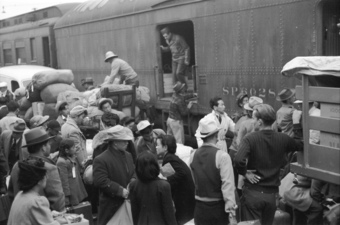
Japanese Americans Sent to Internment Camp
During the Second World War, Japanese Americans were forced to relocate to U.S. government administered internment camps on the baseless suspicion that they may plot anti-American activities.
5.4.3: Civil Rights of Native Americans
Historical policies of American expansion have infringed upon the rights of Native Americans and have lead to long-term inequality.
Learning Objective
Identify the modern civil rights issues that pertain to Native Americans in the United States
Key Points
- 19th and 20th Century policies created a system of Indian reservations, where Native Americans were geographically confined, but had some degree of sovereignty.
- The Indian Civil Rights Act of 1968 extended legal protections against discrimination by the federal government to Native Americans under tribal governance.
- Since the 1970s, affirmative action policies have attempted to provide Native Americans with equal opportunity in housing, employment, and education.
Key Terms
- affirmative action
-
A policy or program providing advantages for people of a minority group with the aim of creating a more racially equal society through preferential access to education, employment, health care, social welfare, etc.
- Indian Civil Rights Act
-
A law that applies to the Indian tribes of the United States and makes many, but not all, of the guarantees of the Bill of Rights applicable within the tribes.
- Indian reservation
-
An area of land managed by a Native American tribe under the United States Department of the Interior’s Bureau of Indian Affairs.
Example
- Relocating Indian populations to reservations during a period of American expansion is an example of what would today be considered a civil rights violation.
Introduction
Native Americans are people of indigenous American descent, including indigenous peoples within the boundaries of the present-day United States. Native Americans are comprised of numerous, distinct ethnic groups, many of which continue as intact cultural and political entities. According to US Census data, 1.37% of Americans identify themselves as Native American.
European Settlement and American Expansion
Prior to the 15th century, groups that were indigenous to the Americas lived in isolation from the rest of the world. Indigenous societies ranged widely in terms of geographic location, culture, and social structure, with distinct languages and governing systems. When Europeans colonized the Americas, massive numbers of Native Americans were killed through warfare and the spread of disease. Of those who survived, most were either forced off the land they inhabited or forced to convert to Christianity and work under Europeans. During the initial phases of American colonization, European policy generally forced Native Americans westward, where there was a low density of European settlement.
By the 1800s, however, the newly formed United States of America sought to expand its territory and strengthen its hold on the western portion of the continent. As settlers moved west, new conflicts with Native American populations ensued. In an attempt to confine Native Americans to limited territory, thus clearing the way for westward expansion, the U.S. government created a system of Indian reservations. Reservations were intended to reduce conflict between settlers and Indians without curbing American expansion, but they were controversial and largely unsuccessful from the start. On the one hand, settlers objected to large portions of land being given to indigenous populations, and on the other, Native Americans objected to having their movement restricted and their territory reduced. Moreover, Native Americans rejected the limited autonomy they were granted through the reservation system, as the reservations were administered by U.S. bureaucrats rather than tribal leaders.
Native Americans in the Modern United States
Today, there are still 310 Indian reservations in the U.S., but they remain controversial. Reservations have alcoholism, domestic abuse, sexual violence, poverty, and illiteracy rates that are among the highest in the country. Partly because of the reservation system, civil rights protections have often involved complex legal issues. Native Americans have allegedly been granted the right to self-determination, which has sometimes limited support on both sides for U.S. governmental protections.
Nonetheless, by 1968 the U.S. Congress passed the Indian Civil Rights Act, which gave tribal members protections from both the U.S. Government and from rights infringements by tribal leaders. Soon after, affirmative action policies began being applied to Native Americans, in an attempt to provide equal opportunity in employment, housing, and education. Despite these efforts, Native Americans still tend to have lower socioeconomic status and greater exposure to crime and abuse than other American groups.
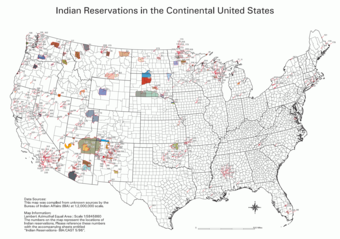
Map of Indian Reservations in the U.S.
Beginning in the 19th century, the U.S. government attempted to reduce conflict and pave the way for territorial expansion by confining Native Americans to reservations, granting them a degree of sovereignty in exchange.
5.4.4: Civil Rights of People with Disabilities
Disabled Americans face limited access to public places and institutions that civil rights legislation seeks to address.
Learning Objective
Describe the campaigns and successes of the disability rights movement.
Key Points
- The Disability Rights Movement arose in the 1960s to create widespread institutional reform that would protect the civil rights of disabled persons in the United States.
- Disability is an umbrella term that includes impairments, activity limitations, and participation restrictions caused by a combination of physical, social, and psychological conditions.
- The 1990 Americans with Disabilities Act mandated improved access to government and social spaces for disabled persons, and also strengthened protections against discrimination.
Key Terms
- disability
-
State of being disabled; deprivation or want of ability; absence of competent physical, intellectual, or moral power, means, fitness, and the like.
- disability rights movement
-
The movement to secure equal opportunities and equal rights for people with disabilities.
- Americans with Disabilities Act
-
A wide-ranging civil rights law that affords similar protections against discrimination to Americans with disabilities as the Civil Rights Act of 1964 did for other groups.
Example
- Outfitting trains and buses with ramps in order to improve access to transportation for disabled persons is an example of a measure designed to meet the requirements of the Americans with Disabilities Act.
Introduction
Disability is an umbrella term that includes impairments, activity limitations, and participation restrictions. Disabilities may be physical, cognitive, mental, sensory, emotional, developmental or some combination of these, and they may be present from birth or acquired later in a person’s lifetime. According to the World Health Organization, an impairment inhibits body function or structure; an activity limitation inhibits an individual’s ability to execute a task or action; and a participation restriction affects an individual’s ability to participate in life situations. Thus, disability is often complex, reflecting an interaction between features of a person’s body and of the society in which he or she lives.
Civil Rights
Disabled persons face unique social challenges that may limit their participation in civic life. Notable issues include:
- Accessibility and safety measures in transportation, architecture, and the physical environment
- Equal opportunity in housing, employment, and education
- Protection from abuse, neglect, and the violation of patients’ rights
To address these concerns, a disability rights movement has introduced a range of legislation and law suits.
The disability rights movement became organized in the 1960s, concurrent with the African-American civil rights movement and feminist movement. Prior to the 1960s, individual disability groups had advocated for social reform; schools for the deaf and blind were organized as early as 1817, and the American Federation of the Physically Handicapped was formed in 1940 to advocate on behalf of people with physical limitations. But, it was not until the 1960s that a diverse range of disability groups became unified in pursuit of large scale advocacy. In the 1960s, the movement included such successful initiatives as the Community Mental Health Act, which provided funding for research about developmental disorders, and the Architectural Barriers Act, which required all federally owned or leased buildings to be accessible to disabled people.
Throughout the 1970s and 80s, the disability rights act gained increasing visibility and a number of policy successes, including increased accessibility of public places and increased resources for people with developmental disabilities. Perhaps the most sweeping success, however, came in 1990 with the passage of the Americans with Disabilities Act. The act provided comprehensive civil rights protections modeled after the Civil Rights Act. It mandated that local, state, and federal governments and programs be accessible to people with disabilities, that employers with more than 15 employees make “reasonable accommodations” for workers with disabilities and not discriminate against otherwise qualified workers on the basis of disability, and that public spaces such as restaurants and stores make “reasonable modifications” to ensure accessibility. The act also mandated the accessibility of public transportation, communication, and other publicly provided services.

Transportation Accessibility
Public transportation vehicles, such as train and bus systems, are required to be outfitted with ramps accessible to disabled persons.
5.4.5: Civil Rights of the Elderly
The elderly, or senior citizens, are vulnerable to civil rights abuses due to a propensity for sickness, disability, and poverty.
Learning Objective
Discuss the civil rights issues that affect the elderly in the United States
Key Points
- Senior citizens are those Americans who are older than the retirement age and who are therefore eligible for state benefits.
- American population shifts have caused the elderly population to expand significantly in recent decades, and it is expected to grow until 2020.
- The Older Americans Act and the Age Discrimination in Employment Act are two pieces of civil rights legislation intended to protect the elderly population.
Key Terms
- Older Americans Act
-
The first federal level initiative aimed at providing comprehensive services for older adults.
- retirement age
-
The age after which a person is eligible for senior citizen benefits, currently 65 in the United States.
- senior citizen
-
An old person, generally, a senior citizen is considered to be over 60 years of age or over the retirement age.
Introduction
The elderly, sometimes referred to as senior citizens in the United States, are a demographic group usually defined by being retired or over the retirement age (which is dependent on life expectancy changes). Due to demographic shifts, including increased life expectancy and high birth rates in the post-World War II era, the United States population has grown older in recent years. As of 1990, only 4% of Americans were over 65; by 2000, 12% were; and demographers estimate that by 2020, 17% will be in that age group.
Civil Rights Issues Affecting the Elderly
Because of a propensity for illness, disability, and lack of employment, the elderly are faced with unique civil rights challenges. Government policies throughout the twentieth century were aimed at meeting the unique needs of elderly Americans. For example, President Franklin D. Roosevelt’s Social Security Act funded medical care for aging Americans. In 1965, President Lyndon B. Johnson signed the Older Americans Act (OAA) into law. This legislation specifically sought to provide equal opportunity for the enjoyment of adequate income in retirement, adequate health care, housing, long-term care, recreation, community services, freedom and self-determination, and protection against abuse, neglect, and exploitation. The OAA provides funding to states for the provision of services on the basis of the percentage of the population over the age of 60. Recipients of the OAA benefits are disproportionately poor, female, rural, and African American, as these elderly populations are particularly vulnerable.

Retirement Home
A large component of non-monetary compensation is retirement funding and similar benefits. Employers will often offer matching or retirement accounts for employees.
Additionally, in 1967, Congress passed the Age Discrimination in Employment Act. This law forbids employment discrimination against anyone who is at least 40 years old in the United States; the denial of benefits based on age; mandatory retirement; and prohibits statements of age preferences in job notices or advertisements. The law attempts to address company policies that force elderly employees out of work once they become eligible for government retirement benefits or due to prejudice against the elderly.
5.4.6: LGBTQ Civil Rights
Lesbian, gay, bisexual, transgender, and queer/questioning (LGBTQ) people have attained many civil protections, but are still subject to discrimination.
Learning Objective
Identify the historical origins and issues relevant for the LGBTQ rights movement
Key Points
- Since roughly the 1950s, the LGBTQ rights movement has worked to protect people from discrimination on the basis of sexual orientation.
- Many policies have changed as a result of the LGBTQ rights movement, such as the legalization of same-sex marriages or civil unions in many states and the overturning of a ban on LGBTQ military service members.
- Despite many policy changes, LGBTQ people are not protected against discrimination by any federal laws, and a powerful conservative movement opposes LGBTQ rights.
- “Don’t Ask, Don’t Tell” (DADT) prohibited military personnel from discriminating against or harassing closeted homosexual or bisexual service members or applicants, while barring openly gay, lesbian, or bisexual persons from military service.
Key Terms
- “Don’t Ask, Don’t Tell” (DADT)
-
A policy in effect between 1991 and 2011 prohibiting military personnel from discriminating against or harassing closeted homosexual or bisexual service members or applicants, while barring openly gay, lesbian, or bisexual persons from military service.
- Stonewall Riots
-
Riots against a police raid that took place on June 28, 1969, at the Stonewall Inn, in the Greenwich Village neighborhood of New York City, which propelled LGBTQ activism and visibility.
- LGBTQ rights movement
-
Activist efforts of individuals and organizations to improve the social and legal standing of lesbian, gay, bisexual, transgender, and queer/questioning (LGBTQ) people.
Introduction
The LGBTQ rights movement refers to the efforts of individuals and organizations to improve the social and legal standing of lesbian, gay, bisexual, and transgender (LGBTQ) people. The Stonewall Riots of 1969 are often thought to mark the starting point of a worldwide LGBTQ rights movement. In fact, some gay and lesbian organizations were established earlier than 1969 and advocated for the improved social standing of LGBTQ people. Still, it was not until the second half of the twentieth century that LGBTQ advocates organized groups and demonstrations to improve the legal status of LGBTQ people.
Despite the long history of non-heterosexual sexual practices and non-conforming gender roles, the concept of lesbian, gay, bisexual, transgender, and queer/questioning (LGBTQ) rights did not become widely used until the second half of the twentieth century. In the early twentieth century in the United States, men and women engaged in homosexual practices and relationships but did not identify as “gay” or “lesbian. ” In New York City in the 1920s, for example, men met in particular social clubs and bars to find male sexual partners. The majority of these men were married and did not consider themselves to be homosexual. While they engaged in homosexual conduct, they generally did not advocate for the improved standing of homosexuals in society. Likewise, throughout the early 1900s, well-educated, unmarried women sometimes lived with long-term female partners. While these relationships were often intimate and resembled marriage, and were sometimes colloquially referred to as “Boston marriages,” the women in these partnerships were more often advocates for women’s rights than for homosexual rights and did not identify as lesbians. The origin of the term “Boston marriages” refer to two single women living together, independent of men. The term was originally coined in Henry James’ novel The Bostonians, which told the tale of an intimate companionship between two wealthy Boston women.
The Stonewall Riots
By the 1950s “homophile organizations” comprised of self-identified homosexual men and women arose. Like earlier social clubs and bars, these homophile club meetings served as a place to meet romantic and sexual partners. But, unlike earlier meeting places, homophile clubs explicitly advocated for the improved social status of homosexual people. While homophile organizations made early explicit attempts to improve LGBTQ peoples’ status, it was not until The Stonewall Riots of 1969 that large numbers of LGBTQ advocates united to demand legal and social rights. Throughout the 1950s-60s LGBTQ people gathered in a small number of bars that welcomed them as customers. Police forces often kept track of which bars were frequented by homosexuals. Since homosexuality was still illegal under anti-sodomy laws, and LGBTQ people had no protections against discrimination, police raids on known gay bars were common.
Don’t Ask, Don’t Tell
“Don’t Ask, Don’t Tell” (DADT) was the official United States policy on gays serving in the military from December 21, 1993, to September 20, 2011. The policy prohibited military personnel from discriminating against or harassing closeted homosexual or bisexual service members or applicants, while barring openly gay, lesbian, or bisexual persons from military service.
The policy was introduced as a compromise measure in 1993 by President Bill Clinton who campaigned in 1992 on the promise to allow all citizens to serve in the military regardless of sexual orientation. In accordance with the December 21, 1993, Department of Defense Directive, it was legal policy that homosexuality was incompatible with military service and that persons who engaged in homosexual acts or stated that they are homosexual or bisexual were to be discharged. he “Don’t Ask” provision mandated that military or appointed officials will not ask about or require members to reveal their sexual orientation. The “Don’t Tell” stated that a member may be discharged for claiming to be a homosexual or bisexual or making a statement indicating a tendency towards or intent to engage in homosexual activities.
A congressional bill to repeal DADT was enacted in December 2010, specifying that the policy would remain in place until the President, the Secretary of Defense, and the Chairman of the Joint Chiefs of Staff certified that repeal would not harm military readiness, followed by a 60-day waiting period. A July 6, 2011, ruling from a federal appeals court barred further enforcement of the U.S. military’s ban on openly gay service members. President Barack Obama, Secretary of Defense Leon Panetta, and Chairman of the Joint Chiefs of Staff Admiral Mike Mullen sent that certification to Congress on July 22, 2011, which set the end of DADT for September 20, 2011.
Successes and Challenges
Since the late-1960s, LGBTQ activists have achieved many successes in the struggle to secure civil rights for LGBTQ people. Notably, in the past decade many states have legalized same-sex marriages and civil unions, the federal government overturned a ban on open LGBTQ military service members known as Don’t Ask, Don’t Tell (DADT), and most states have passed anti-discrimination laws that prevent discrimination in housing, employment, and education on the basis of sexual orientation. Although gay marriage is legal nationally, and no federal law protects LGBTQ people from discrimination.
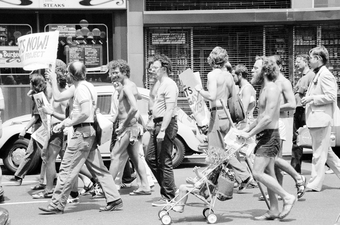
Gay Rights Demonstration
By the late 1960s, cities across the country held gay rights demonstrations to oppose discrimination on the basis of sexual orientation.
5.4.7: Civil Rights of Immigrants
Immigrants are vulnerable to civil rights violations, often due to low socioeconomic status, language barriers, or xenophobia.
Learning Objective
Discuss the history of immigration to the United States
Key Points
- In the early history of the United States, the largest numbers of immigrants were comprised of Europeans seeking economic opportunity and Africans who were forcibly brought to the U.S. as slaves.
- Throughout much of the 20th century, immigration to the U.S. was heavily restricted, but the Immigration and Nationality Act of 1965 lifted prior quotas and allowed many new immigrants into the country.
- The largest immigrant populations in the U.S. today are Latinos and Asian-Americans, though the former group is the subject of significantly more political controversy.
Key Terms
- immigration
-
Coming into a non-native country for the purpose of permanent residence.
- Immigration and Nationality Act
-
Law that abolished country of origin quotas on immigration.
- The Dream Act
-
Proposed legislation that would provide conditional permanent residency to certain undocumented residents of good moral character who graduate from U.S. high schools, arrived in the United States as minors, and lived in the country continuously for at least five years prior to the bill’s enactment. This proposed legislation has been introduced at least 5 times in Congress since 2001, but has failed to pass both houses.
Example
- Paying migrant farm workers less than minimum wage is a civil rights violation carried out against a primarily immigrant population. The United Farm Workers union, led by Cesar Chavez, directly addressed this illegal exploitation of workers.
History
Immigration is the movement of people from one country to a country in which they are not native. In the United States, immigration has a long and complex history. It has long been a source of population growth as well as cultural, social, and political change.
In the first two centuries of the United States’ history, new immigrants were primarily north European, African, and Caribbean. Europeans immigrated primarily for economic opportunity, though some groups moved in pursuit of religious freedom or political asylum. Virtually all immigration from Africa and the Caribbean was the result of slavery — the movement of Africans and Caribbean Islanders from their native countries was entirely involuntary.
By the mid-1800s, increasing numbers of southern and eastern Europeans were immigrating to the United States. Many new groups were met with xenophobia. For example, in the second half of the 1800s, the Irish population in the U.S. exploded, and anti-Irish sentiment resulted in a plethora of discriminatory practices in housing, employment, and governance.
For much of the twentieth century, immigration was severely restricted by legislation with an isolationist philosophy. It was not until the passage of the Immigration and Nationality Act of 1965 that significant numbers of immigrants were once again allowed to enter the U.S. The Immigration and Nationality Act reversed laws that limited the number of immigrants who could enter from any given country, and instead put in place policies that encouraged the immigration of skilled workers and family members of U.S. citizens.
Contemporary Debates
At present, the two largest immigrant groups in the United States are Latinos and Asian-Americans. While there is general political debate surrounding immigration, the bulk focuses on Latinos. This trend is largely due to the high socio-economic status of Asian immigrants — compared to other groups, Asian immigrants tend to be well-educated, and second-generation Asian-Americans immigrants tend to have high incomes and educational attainment. Latino immigrants, on the other hand, comprise a poorer, less-educated population. Consequently, they are more vulnerable to civil rights violations and lack of legal protection.
All immigrants are affected by certain civil rights issues, though Latinos may be more vulnerable than other groups. Central issues include the low enforcement of labor laws with regards to immigrant workers who are subject to dangerous or exploitative conditions; lack of due process in the courts for residents who entered the country illegally; debates about whether languages other than English should be taught in public schools and used in government documents; and debates about whether children who entered the country illegally can be prosecuted and deported. The Dream Act is an example of recently proposed legislation that would allow children born to parents who are illegally in the U.S. to attend public universities and become citizens .Although the Dream Act has not passed as federal legislation, a California version was passed in 2011. The California DREAM (Development, Relief, and Education for Alien Minors) Act is a package of California state laws that allow children who were brought into the US under the age of 16 without proper visas/immigration documentation who have attended school on a regular basis and otherwise meet in-state tuition and GPA requirements to apply for student financial aid benefits.
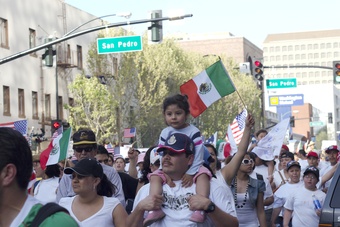
Mexican-American Rights March
Mexican-American immigrants have organized many political demonstrations to protest the exploitation of workers, discrimination in education and employment, and heavy-handed criminal justice enforcement against illegal immigrants.
While illegal immigration is the most controversial issue in American politics, immigrants who enter the country legally also face civil rights challenges. Discrimination in housing, employment, and education is legally prohibited, but continues to impact many immigrants, especially those who may be vulnerable due to a language barrier or their economic status.
5.5: Affirmative Action
5.5.1: The Supreme Court and the Burden of Proof
The Supreme Court is the highest court in the United States and has ultimate jurisdiction over all courts that involve a contest of federal law.
Learning Objective
Describe the structure and function of the Supreme Court
Key Points
- The Supreme Court hears cases from lower courts and decides the law of the United States.
- The Court expresses its views in a legal opinion, which much have a majority opinion and may have concurrences and dissents.
- Though the Supreme Court is supposed to be politically independent, the current court’s opinions are more frequently embraced by conservatives than by liberals.
Key Terms
- opinion
-
A statement of judicial finding that becomes law.
- Supreme Court of the United States
-
The highest court in all of the United States, one that can hear and decide cases from all lower courts.
The Supreme Court of the United States
The Supreme Court is the highest court in all of the United States. Any lower (more local) court can appeal a ruling to the Supreme Court. In other words, it has ultimate, but largely discretionary, appellate jurisdiction over all courts that involve a contest of federal law. The Court consists of a chief justice and eight associate justices who are nominated by the President and confirmed by the United States Senate. Once appointed, justices have life tenure unless they resign, retire, or are removed after impeachment. The sitting court consists of Chief Justice John Roberts, Anthony Kennedy, Clarence Thomas, Ruth Bader Ginsburg, Stephen Breyer, Samuel Alito, Sonia Sotomayor, and Elena Kagan. No replacement has been made to fill the open seat resulting from the death of justice Antonin Scalia on Feb. 13, 2016.
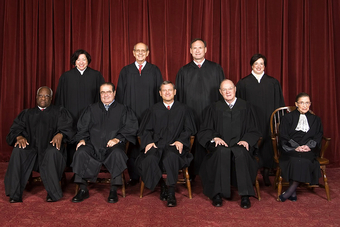
The U.S. Supreme Court
The United States Supreme Court, the highest court in the United States, in 2010. Top row (left to right): Associate Justice Sonia Sotomayor, Associate Justice Stephen G. Breyer, Associate Justice Samuel A. Alito, and Associate Justice Elena Kagan. Bottom row (left to right): Associate Justice Clarence Thomas, Associate Justice Antonin Scalia, Chief Justice John G. Roberts, Associate Justice Anthony Kennedy, and Associate Justice Ruth Bader Ginsburg.
The Supreme Court is the head the judicial branch, one of the three branches of American government (the other two being the executive branch and legislative branch). Of the three, the Supreme Court is supposed to be politically independent, and thus not wed to either the Democratic or Republican Party. However, the nomination process itself essentially ensures that some partisanship, or allegiance to a political party, appears on the Court. A partisan president nominates a justice and a partisan Senate must confirm a justice. Justices are thus categorized in legal and political circles as being judicial conservatives, moderates, or liberals. Though explicitly not for political motivations, judicial conservatives tend to confirm Republican agendas while judicial liberals tend to support Democratic aims. Ideally, their legal holdings are independent of their political views, though the degree to which this is true in practice is highly contested. The current court tends to lean conservatively in its opinions.
The Supreme Court decides which cases it would like to hear. Allowing a case to come before the court is called granting a writ of certiorari or granting cert. But for a small set of limited exceptions, the Court only hears cases that have already been reviewed by a lower court, meaning that the Supreme Court is a court of appeal. The party that lost the case in the lower court is called the petitioner and the party that won in lower court is called the respondent. The names of all of the cases that come before the court are structured as Petitioner v. Respondent, regardless of which party brought suit in the lower court. After granting cert, lawyers for each party will submit briefs, or written legal arguments, about the issues for the Court to read before oral arguments, or the time when a lawyer from each side will argue his case before all of the justices. After oral arguments, the justices will meet to discuss the case and then issue an opinion, or written statement of their findings, weeks or months later.
Not all justices have to agree on the finding of the court; in fact, they rarely unanimously agree. Instead, the justices will vote on the issues before them and the majority vote will constitute the legal opinion and law of the United States. Because of this voting process, you will frequently see the score for the vote (justices for and against). For example, in the case of Roe v. Wade (1973), the case that established federal abortion law in some instances of pregnancy became law by a vote of 7-2. The opinion will describe the justices’ reasons for voting as they did. The part of the opinion that address the majority vote and the new law of the land is called the majority opinion, while the part of the opinion that describes the rationale for the minority voters is called the dissent. One justice can write an opinion to which other justices will sign, though justices will frequently write their own opinion. When a justice that voted with the majority writes his or her own opinion, it is called a concurrence. You will frequently find opinions that contain several concurrences and dissents.
5.5.2: Referenda on Affirmative Action
Affirmative action measures, particularly those pertaining to higher education, have been politically controversial in the United States.
Learning Objective
Identify four key referenda challenging affirmative action programs
Key Points
- Affirmative action refers to the integration of minorities in higher education settings and equal opportunity employment.
- Referenda have been issued across the country so that citizens can vote on this politically controversial issue.
- California, Washington, Michigan, and Nebraska have all passed referenda to limit the use of affirmative action in their states.
Key Terms
- affirmative action
-
A policy or program providing advantages for people of a minority group with the aim of creating a more racially equal society through preferential access to education, employment, health care, social welfare, etc.
- referendum
-
A direct popular vote on a proposed law or constitutional amendment.
In the United States, affirmative action refers to two different institutional capacities: 1) the proactive integration of minorities in settings of higher education, possibly by the use of different admissions standards and 2) equal opportunity employment measures that federal contractors are legally required to adopt. Affirmative action measures, particularly those pertaining to higher education, have been politically controversial in the United States. Though the majority of legal discussions about affirmative action have pertained to law suits, many states have had referenda on the topic. A referendum is a direct vote in which an entire electorate (citizens of particular states, in these cases) is asked to either accept or reject a particular proposal.
Major Affirmative Action Referenda in the United States
In California, Proposition 209 (the California Civil Rights Initiative) was passed in 1996 and amended the state constitution to prohibit state government institutions from considering race, sex, or ethnicity, specifically in the areas of public employment, public contracting, and public education. Proposition 209 was passed with 54% of the electorate approving of the initiative. The most controversial aspect of Proposition 209 was the element that applied to public education. Prior to the passage of the proposition, the University of California system had used mechanisms of affirmative action. Since the passage of Proposition 209, higher graduation rates have be been posted across all of the University of California, leading opponents of affirmative action to suggest a causal link between Proposition 209 and a better prepared student body. However, while minority graduation rates have risen, enrollment rates have decreased. Of the 4,422 student in UCLA’s class of 2006, only 100 (2.26%) were African American. Since the passage of Proposition 209, enrollment rates for African Americans and Latinos have declined significantly, while rates have increased for Asian Americans.
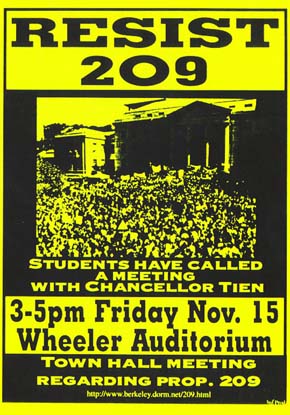
Protests of California’s Proposition 209
Hundreds of students protested Proposition 209 at the University of California – Berkeley.
Several other states were inspired by California’s referendum. In 1998, the state of Washington sought to prohibit racial and gender preferences by state and local government. The initiative passed with 58.22% of the vote, adding the following language to Washington’s laws: “The state shall not discriminate against, or grant preferential treatment to, or any individual group on the basis of race, sex, color, ethnicity, or national origin in the operation of public employment, public education, or public contracting.”
The Michigan Civil Rights Initiative (MCRI, or Proposition 2), was a ballot initiative that passed into Michigan Constitutional law by a 58% to 48% vote in 2006. The MCRI was legislation aimed at stopping the preferential treatment of minorities (by race, color, sex, or religion) in receiving admission to colleges, jobs, and other publicly funded institutions. However, the MCRI was overturned by the United States Court of Appeals for the Sixth Circuit in 2011. Bill Schutte, Attorney General for the State of Michigan, announced that he was appealing the Sixth Circuit’s decision, so the MCRI is in effect until the appeal is complete.
The Nebraska Civil Rights Initiative, or Initiative 424, was a 2008 ballot measure that proposed a constitutional amendment which would prohibit the state from discriminating against or granting preferential treatment to “any individual on the basis of race, sex, color, ethnicity, or national origin in the operation of public employment, public education, or public contracting.” The measure, in effect, banned affirmative action at the state level. It passed with 58% of the vote.
5.5.3: Controversies Surrounding Affirmative Action
Opponents have tested affirmative action programs politically and legally through referendums and lawsuits since the 1970s.
Learning Objective
Analyze the response to the rise of affirmative action programs
Key Points
- Since the 1970s, affirmative action programs, particularly those in higher education, have been tested politically and legally by its opponents.
- Referendums have curtailed affirmative action programs in California, Michigan, Washington, and Nebraska.
- Lawsuits have also questioned the constitutionality of affirmative action programs.
Key Terms
- referendum
-
A direct popular vote on a proposed law or constitutional amendment.
- affirmative action
-
A policy or program providing advantages for people of a minority group with the aim of creating a more racially equal society through preferential access to education, employment, health care, social welfare, etc.
- reverse racism
-
Racism against either a person or people of a racial majority as a result of favorable treatment given to the minority.
Since the 1970s, affirmative action programs, particularly those in higher education, have been tested politically and legally by its opponents. Proponents of affirmative action contend that affirmative action programs give minorities the same educational advantages and opportunities that should be afforded to all races and attempt to compensate for past institutional racism. Proponents further argue that affirmative action programs encourage the elimination of racism by demonstrating that people from all different backgrounds can succeed in educational and professional settings.
However, supporters of affirmative action have encountered opposition. Some opponents have tested the bases for affirmative action programs on the basis of class inequality. These opponents argue that the program actually benefits middle- and upper-class African and Hispanic Americans at the expense of lower-class European and Asian Americans. This argument supports the idea of solely-class based affirmative action or the idea that affirmative action programs should be instituted based on social class rather than race . Other opponents have tested affirmative action by arguing that these programs lower admission standards for educational and professional environments and stating that affirmative action is a form of reverse racism, by which Caucasians are disadvantaged in the same way that minorities were in the past.
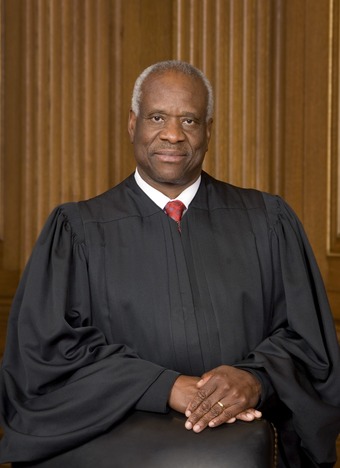
Justice Clarence Thomas
Supreme Court Justice Clarence Thomas has argued that affirmative action programs disadvantage minority students because others think that they achieved success due to affirmative action rather than their own merits.
Opponents of affirmative action have tried to disassemble affirmative action programs. States such as California, Michigan, Washington, and Nebraska have held a referendums, turning the issue over to voters on a direct ballot measure. In all four of these states, voters demanded that state institutions, including public institutions of higher education, disband all programs that take race and ethnicity into account for admissions. Affirmative action programs have engendered lawsuits disputing their constitutionality. These suits are normally sought by Caucasian students who were not admitted to institutions of higher education while lower scoring minority students were admitted. The most famous of these cases include Regents of the University of California v. Bakke (1978), Hopwood v. Texas (1996), Grutter v. Bollinger (2003), Gratz v. Bollinger (2003), and Parents Involved in Community Schools v. Seattle School District No. 1 (2006). Each of these cases has more narrowly defined the instances in which public schools can factor race into account in admissions.
5.5.4: Strict Scrutiny
The legal standard of strict scrutiny, the most stringent standard of judicial review, must be used in all court cases involving affirmative action.
Learning Objective
Describe the three tests a law faces under a strict scrutiny standard
Key Points
- Courts employ different legal standards to evaluate the constitutionality of legal claims; all cases of affirmative action must pass the strict scrutiny test.
- To pass the strict scrutiny test, the state must demonstrate that the state has a compelling governmental interest in the program or law, that the law or program is narrowly tailored to suit the compelling governmental interest, and that the state is using the least restrictive means.
- The court must use the strict scrutiny test because affirmative action programs constitute suspect classification, or preferential treatment based on race.
Key Terms
- suspect classification
-
When the government classifies individuals along racial lines and treats minority populations differently than the majority population.
- strict scrutiny
-
The most stringent standard of legal review in American courts, used to evaluate the constitutionality of laws and government programs.
- constitutional
-
Conforming to the constitution.
Strict scrutiny is the most stringent standard of judicial review used in American courts . It is part of the hierarchy of standards that courts use to weigh the government’s interest against a constitutional right or principle. The other members of the hierarchy of standards are, at the lowest level, “rational basis review” and, at the intermediate level, “intermediate scrutiny.”
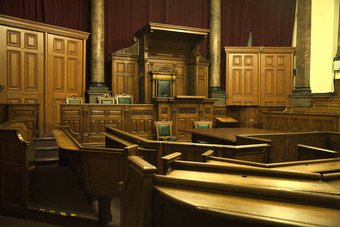
Strict Scrutiny
Courts must use strict scrutiny to evaluate affirmative action programs.
Strict scrutiny is the standard that is employed in litigating affirmative action cases. Strict scrutiny is applied by judges in these cases because they give preferential treatment to a class of citizens–racial minorities. Whether the treatment is justified or not is politically contentious, but the treatment is recognized as legally preferential. Because affirmative action programs do not treat citizens equally, the implementation of affirmative action programs must pass the strict scrutiny standard for the programs to be constitutional, or legal and in accordance with the law and principles outlined in the American Constitution.
Judges apply strict scrutiny tests when a case regarding affirmative action come before them. In other words, in order to determine the constitutionality of the contested program, the judge must determine whether or not the program meets the standards of a strict scrutiny test. To meet these standards, the law or program must satisfy three tests:
- The program must be justified by a compelling governmental interest. This concept refers to something that is necessary or crucial for the functioning of the state, rather than just something that the state wants. An example of a compelling governmental interest would be national security. Whether or not the state has a compelling governmental interest in the incorporation of minority students in places of public education is a key question in any affirmative action case coming before the court.
- The law or program must be narrowly tailored to achieve the state’s compelling governmental interest. For example, even if the court found that states had a compelling governmental interest in incorporating minority students, the state would have to demonstrate that its program only incorporated eligible candidates. A person could not be admitted to an institution of higher education simply because of his racial background.
- The law or program must use the least restrictive means for achieving the state’s compelling governmental interest; that is, there cannot be a less restrictive way to effectively achieve the compelling governmental interest.
When the court uses the strict scrutiny standard to evaluate affirmative action cases, the court is employing the standard because the court must do so in every case of suspect classification. These are cases in which a petitioner is questioning the state’s categorization and treatment of a particular minority group of citizens. Affirmative action cases fall in this category. For the classification to be constitutional, the class must have experienced a history of discrimination, must be definable as a group, must have limited political powers, and its characteristic must have little relationship to the government’s policy aims or the ability of the group’s members to contribute to society. The Supreme Court has consistently found that classification based on race, national origin, and alienage require strict scrutiny review. Thus, it is used in all legal contestations of affirmative action.
5.5.5: The Diversity Debate
Debates over affirmative action center around the question of whether diversity in the classroom merits a program of state intervention.
Learning Objective
Reconstruct frequently-made arguments for and against affirmative action in higher education
Key Points
- Debates about affirmative action question the need and usefulness of state schemes for racial integration in the classroom.
- Brown v. Board of Education made it illegal to segregate public education; affirmative action programs claim that the government needs to be proactive in integrating minorities.
- Opponents of affirmative action claim that the program encourages a sensitivity to race rather than the development of a colorblind world.
Key Terms
- affirmative action
-
A policy or program providing advantages for people of a minority group with the aim of creating a more racially equal society through preferential access to education, employment, health care, social welfare, etc.
- Brown v. Board of Education
-
The Supreme Court case that ruled segregated education unconstitutional.
Racial diversity in American schools remains a contentious political issue. Should public schools go out of their way to attract minority students? Does the government have a serious interest in the balancing of racial populations in education? Does a racially diverse classroom support educational goals? These questions are at the heart of the debate over affirmative action.
The institutional practice of slavery, and later segregation, in the United States prevented certain racial groups from entering the school system, particularly systems of higher education, until midway through the 20th century when the Supreme Court case of Brown v. Board of Education forbade racially segregated education. The Court ruled that school segregation stunted the educational development of minority children. Though Brown became law, most counties in the Southern United States did not fully integrate their schools until the 1970s.
Affirmative action programs in higher education are, of course, different from the desegregation programs of the mid-twentieth century. In affirmative action programs, the state goes beyond ensuring de jure equality for racial minorities in public education and makes strides to create conditions for de facto equality. Supporters of affirmative action believe that these types of proactive programs prove that all students benefit from racial diversity in the class room, and that institutional forms of racism have precluded members of the minority community from entering spaces of higher education. Some believe that racial and ethnic diversity in schools fosters understanding of new cultures and beliefs systems, dispelling stereotypes held by the majority population . Since the mid-twentieth century, researchers have found that benefits of racial diversity in schools range from higher reading levels, increased likelihood of high school graduation, positive impact on work aspirations and higher educational attainment, greater interaction with other racial groups and creation of interracial friendships in adult life, and higher desire to live and work in racially diverse environments.

Diversity in Education
Supporters of affirmative action programs posit that all students benefit from diversity in schools.
In addition to the perceived legal obstacles to the implementation of affirmative action programs, some opponents of affirmative action believe that race-conscious approaches to diversity in the classroom are harmful. They perceive little correlation between racial diversity in the classroom and increased performance by minority students. These theorists believe that focusing on race in diversity policies creates a heightened awareness of racial difference and perpetuates discrimination. Rather, these individuals usually support colorblind policies to instill the norm that skin color does not matter.
5.5.6: The Supreme Court Revisits Affirmative Action
The first affirmative action case to come before the Supreme Court dealt with affirmative action in employment.
Learning Objective
Summarize the facts of the case Griggs v. Duke Power
Key Points
- As a concept, affirmative action developed in relation to employment and only later was applied to institutions of higher education.
- The first court case addressing affirmative action was Griggs v. Duke Power Co. in 1971.
- The Supreme Court held that Duke’s hiring tests, which disadvantaged minority candidates, were not reasonably related to the job at hand and thus unconstitutional.
Key Terms
- Griggs v. Duke Power Co.
-
The first Supreme Court case in the US to address affirmative action in 1971.
- affirmative action
-
A policy or program providing advantages for people of a minority group with the aim of creating a more racially equal society through preferential access to education, employment, health care, social welfare, etc.
Though the current debate over affirmative actionin the United States generally refers to affirmative action programs in admissions to institutions of higher education, the term originally developed in regard to actions to proactively hire candidates from minority backgrounds. Examples of affirmative action programs offered by the US Department of Labor include outreach campaigns, targeted recruitment, employee and management development, and employee support programs. In broad terms, affirmative action programs in employment refer to the preferential treatment of minority employees in the hiring or management process.
The first Supreme Court cases adjudicating affirmative action dealt with affirmative action in cases of employment. The first court case in the United States over affirmative action was Griggs v. Duke Power Co., 401 U.S. 424, in 1971. In the 1950s, Duke Power’s Dan River plan had a policy that African-Americans were allowed to work only in its Labor Department, which constituted the lowest-paying positions in the company. In 1955, a time when even public education served as a barrier between whites and African Americans, the company added the requirement of a high school diploma for its higher jobs. After the passage of the Civil Rights Act in 1964, the company removed the racial restriction, but retained the high school diploma requirement, and added the requirement of an IQ test, with the racist belief that African Americans would score lower than whites on an IQ test. African Americans were far less likely to be hired than white candidates. It was found that white people who had been working at the firm for some time but met neither of the new requirements performed their jobs as well as those that did meet the requirements.
The court ruled that Duke Power’s employment requirements did not pertain to applicants’ abilities to perform the job and so was discriminating against African-American employees, even if Duke Power hadn’t intended for the policy to have that effect . The Supreme Court ruled that under Title VII of the Civil Rights Act, if the IQ and diploma tests disparately impacted ethnic minority groups, businesses must demonstrate that such tests are “reasonably related” to the job for which the test is required. Duke Power’s requirements did not pass this legal standard, and thus the case was decided against Duke Power.
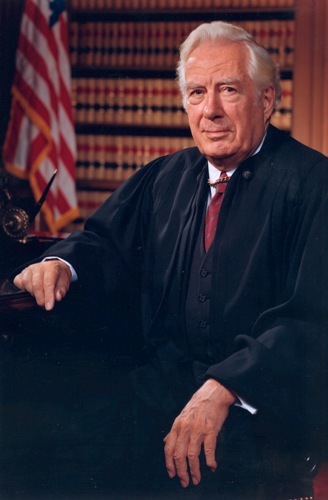
Chief Justice Burger
Chief Justice Warren E. Burger authored the opinion of the court in Briggs v. Duke Power Co. in 1971.
5.5.7: State Initiatives Against Affirmative Action
States and the federal government have argued about the appropriate implementation of affirmative action policies.
Learning Objective
Assess the relationship between states and the federal government in matters related to affirmative action
Key Points
- States have sought to limit the federal government’s implementation of affirmative action policies.
- The most effective state actions against affirmative action have occurred through referenda.
- The federal government has pushed back against state opposition to affirmative action policies.
Key Terms
- referendum
-
A direct popular vote on a proposed law or constitutional amendment.
- Griggs v. Duke Power Company
-
The 1971 Supreme Court case in which the federal government first adjudicated affirmative action, ruling that states cannot limit access to employment for minorities; limitations for employment must be related to work performance.
Following the decision of Griggs v. Duke Power Company, the first court case to assess affirmative action in employment that made it to the Supreme Court in 1971, states took action to limit the application of affirmative action programs in their jurisdictions. This case decided for the minority petitioners, asserting that companies could not impose policies that raised obstacles for minority applicants so long as the the fulfillment of the policies were not reasonably related to job performance. States sought to limit the reach of federal policies regulating employment standards.
However, the scope of affirmative action debates soon extended beyond employment and entered the domain of higher education. Opponents to affirmative action have been even more vociferous about the use of affirmative action in higher education than when affirmative action pertains to employment policies. Since 1996, citizens of Arizona, Nebraska, California, Michigan, and Washington have all sponsored referendums to limit the legality of affirmative action policies . Since voters passed the referenda, the law in Michigan has been put on hold while the Michigan courts assess the constitutionality of voters’ limitations.
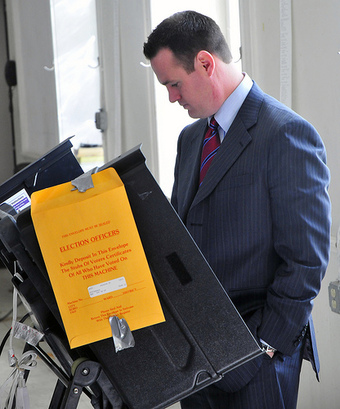
State Initiatives Against Affirmative Action
State referenda have been the most successful way for opponents of affirmative action to limit its reach.
Since the implementation of state policies resisting affirmative action programs, the federal government has pushed back to ensure that affirmative action policies are implemented. In 1973, the U.S. Congress passed Section 717 of Title VII of the Civil Rights Act and Section 501 of the Rehabilitation Act, both of which require all U.S. federal agencies to implement affirmative employment opportunity programs for all federal employees. In 1979, President Carter issued U.S. Executive Order 12138, creating a National Women’s Business Enterprise Policy and requiring government agencies to take affirmative action in support of women’s business enterprises. As for the judicial branch, in 1995, the Supreme Court heard Adarand Constructors v. Peña, which established strict scrutiny standards of review for race and ethnicity-based federal affirmative action programs.
Thus, one can see that affirmative action policies and programs have gone back and forth between the states and federal government, typically with state voters trying to limit the reach of affirmative action and the federal government insisting on implementation.
5.5.8: Regents of the University of California v. Bakke
The 1978 Supreme Court case Bakke was the first case before the Court of affirmative action in higher education.
Learning Objective
Analyze the Supreme Court’s decision in Bakke v. University of California (Davis)
Key Points
- Regents of the University of California v. Bakke (1978) was the first case before the U.S. Supreme Court that evaluated the constitutionality of affirmative action programs in admissions for higher education.
- Bakke held that universities could use affirmative action in admissions and consider racial background “a plus,” but could not establish quota systems like that in place in Bakke.
- The Bakke holding was confusing and far from unanimous. It opened space for decades of further debate over affirmative action in higher education.
Key Terms
- quota systems
-
An affirmative action program in which a certain number of spots in any class of higher education or employment are reserved for minority applicants.
- affirmative action
-
A policy or program providing advantages for people of a minority group with the aim of creating a more racially equal society through preferential access to education, employment, health care, social welfare, etc.
In 1973, Allan Bakke, a 33-year-old white male, applied to 12 medical schools. He had been a National Merit Scholar in high school and graduated from the University of Minnesota with a GPA of 3.51. Bakke had served in Vietnam. After college, he and went on to work as an engineer at NASA. Bakke said that his interest in medicine began while serving in Vietnam and increased at NASA, as he had to consider the problems of space flight for the human body. All 12 schools rejected his application, including the University of California, Davis School of Medicine .

University of California, Davis School of Medicine
Bakke was adjudicated as a result of the 1970’s admissions policies of the University of California, Davis School of Medicine.
At that time, UC Davis was employing an overt form of affirmative action. The school had 100 seats available to applicants, 16 of which were specifically for “Blacks,” “Asians,” “Chicanos,” and “American Indians” under an affirmative action program. By siphoning off these 16 spaces, UC Davis created a separate admissions process for those 16 seats alone. Bakke sued the Regents of the University of California based on the fact that these 16 seats were off limits for him based on race and that minorities had been admitted to fill these 16 seats with lower academic scores than Bakke. He sued to have the state force UC Davis to admit him.
The Supreme Court heard the case in 1978. There were two main issues before the Court: 1) Was it illegal and unconstitutional under Section VI of the Civil Rights Act of 1964 for Bakke’s to be excluded from consideration in UC Davis Medical School special admissions program for minorities? And 2) If Bakke’s exclusion was unconstitutional, should UC Davis be required to admit him?
The strongest contention by the University of California in countering the law suit was the justification of affirmative action by the good of diversity in the classroom. UC Davis’s admissions procedure was designed to increase diversity. UC Davis maintained that the program had originally been developed to 1) reduce the historic deficit of traditionally disfavored minorities in medical schools and the medical profession, 2) counter the effects of societal discrimination, 3) increase the number of physicians who will practice in under served communities, and 4) obtain the educational benefits that flow from a racially diverse student body.
Though fragmented and far from a unanimous decision, the Court ultimately held that affirmative action programs are constitutional. However,quota systems, such as that established by UC Davis, were unconstitutional. In other words, the state could enact programs that preference the applications of minority candidates in the name of campus diversity, but could not reserve a certain number of seats for minority applicants and use an entirely different admissions process.
Bakke is significant for its holding and for the role of the decision in the adjudication of affirmative action. Bakke was the first case the Supreme Court decided that referenced affirmative action policies in higher education. Further, the nuances and confusions surrounding the Bakke decision set the stage for decades of future adjudication over affirmative action. The Court did not establish a precise ruling, but rather opened the door for future debates.
5.5.9: The End of Affirmative Action?
Since Bakke, the Supreme Court has been questioning the constitutionality of affirmative action programs.
Learning Objective
Analyze the two affirmative action cases in which the University of Michigan was involved in the early 2000s
Key Points
- In 2003, Gratz v. Bollinger held that the use of point systems in college admissions, where certain races are given a high number of points, are unconstitutional.
- In 2003, Grutter v. Bollinger held that the consideration of race in law school admissions without a point or quota system is constitutional.
- In 2012, the Court will hear Fisher v. University of Texas which could dismantle the use of affirmative action in public, higher education programs in the US.
- In the United States, multiculturalism is not clearly established in policy at the federal level, but ethnic diversity is common in both rural and urban areas.
- The idea of the Melting pot is a metaphor that implies that all the immigrant cultures are mixed and amalgamated without state intervention.
- Critics of multiculturalism often debate whether the multicultural ideal of benignly co-existing cultures that interrelate and influence one another, and yet remain distinct, is sustainable, paradoxical, or even desirable.
Key Terms
- Fisher v. University of Texas
-
A court case coming before the Supreme Court in 2012 that has the potential to dismantle affirmative action in public education.
- Grutter v. Bollinger
-
A 2003 Supreme Court case that found that considering race without a point or quota system in law school admissions is constitutional.
- Gratz v. Bollinger
-
A 2003 Supreme Court case in which the court held that giving race a certain number of points in admissions decisions at the University of Michigan College of Literature, Science, and Arts was unconstitutional.
Multiculturalism in America
Multiculturalism relates to communities containing multiple cultures. In the United States, multiculturalism is not clearly established in policy at the federal level, but ethnic diversity is common in both rural and urban areas. Continuous mass immigration was a feature of the United States economy and society since the first half of the 19th century. The absorption of the stream of immigrants became, in itself, a prominent feature of America’s national myth. The idea of the Melting pot is a metaphor that implies that all the immigrant cultures are mixed and amalgamated without state intervention
Critics of multiculturalism often debate whether the multicultural ideal of benignly co-existing cultures that interrelate and influence one another, and yet remain distinct, is sustainable, paradoxical, or even desirable. It is argued that Nation states, who would previously have been synonymous with a distinctive cultural identity of their own, lose out to enforced multiculturalism and that this ultimately erodes the host nations’ distinct culture.
Affirmative Action in America
Since the case of Regents of the University of California v.Bakke in 1978, several Supreme Court cases have revisited questions of affirmative action in higher education. The majority of these cases have limited universities’ abilities to incorporate race into admissions .
In 2003, the Supreme Court heard the case of Gratz v. Bollinger, regarding the undergraduate admissions policies of the College of Literature, Science, and Arts at the University of Michigan. The University of Michigan used a 150-point scale to rank applicants, with 100 points needed to guarantee admission. The University gave underrepresented ethnic groups, including African-Americans, Hispanics, and Native Americans an automatic 20-point bonus on the scale. As a point of comparison, a perfect SAT score was worth 12 points. After being denied admission, Jennifer Gratz filed suit on the basis that the University of Michigan’s point system discriminated against her on the basis of race, as she belonged to none of the specified minority groups. The Supreme Court held that the university could still consider race in college admissions, but that the University of Michigan’s ranking and point system was unconstitutional because it gave an automatic point increase to all racial minorities rather than considering what a specific individual could contribute to campus life.
The Supreme Court is expected to rule again on affirmative action in the upcoming term in the case of Fisher v. University of Texas. The case is brought by Abigail Fisher after she was denied admission to the University of Texas at Austin. UT Austin guarantees admission to the top 10% of students in every high school class, regardless of race. Fisher was not in the top 10% and was therefore evaluated based on her merits. She contends that race plays too great of a role in the decision making for students outside of the 10% rule.
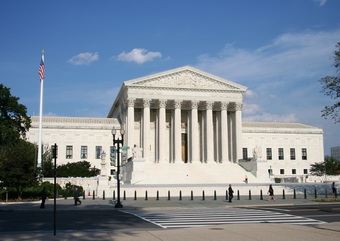
The Supreme Court Building
Since Bakke in 1978, the Supreme Court has slowly been limiting the types of affirmative action programs that are deemed constitutional.
